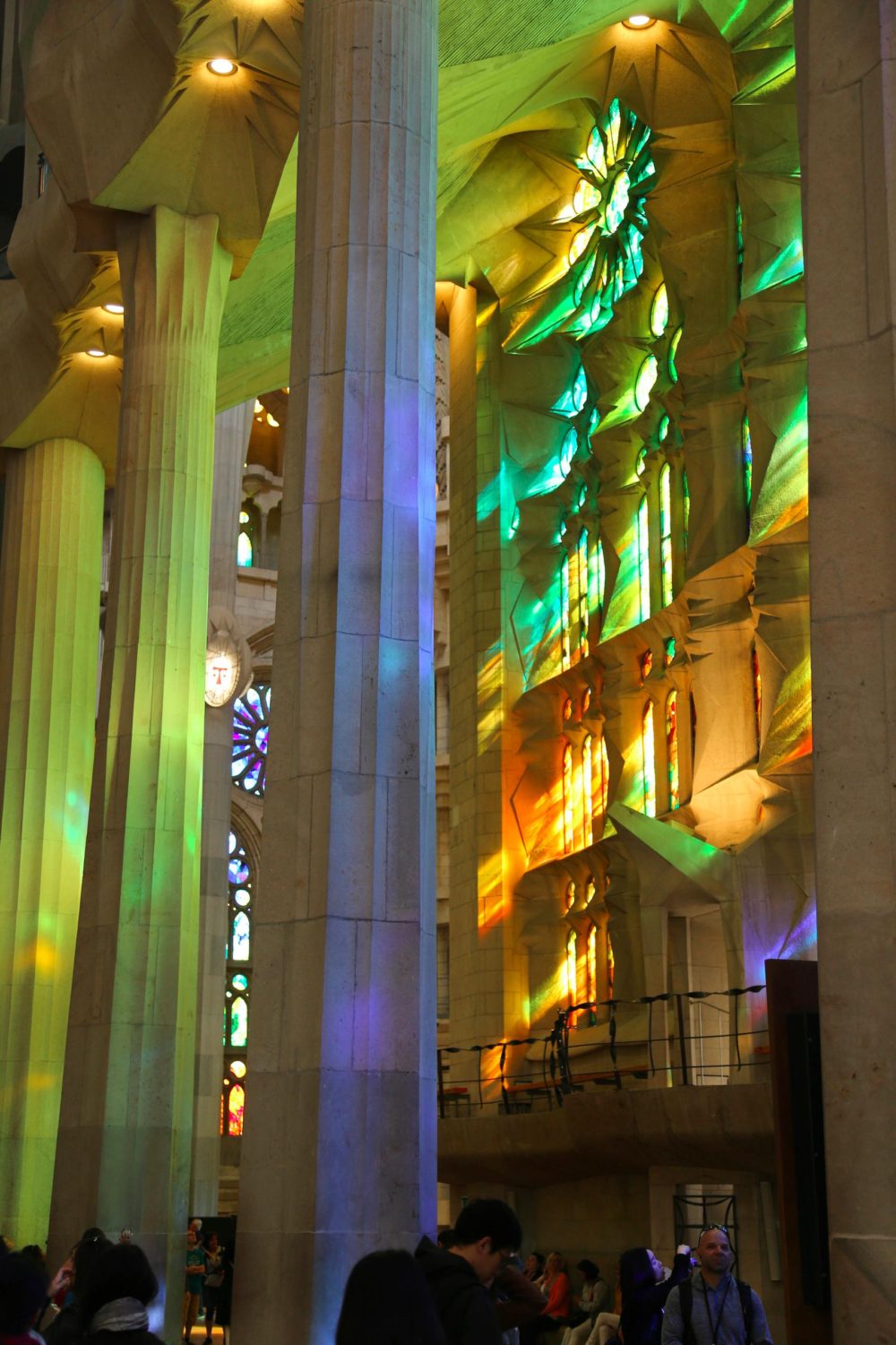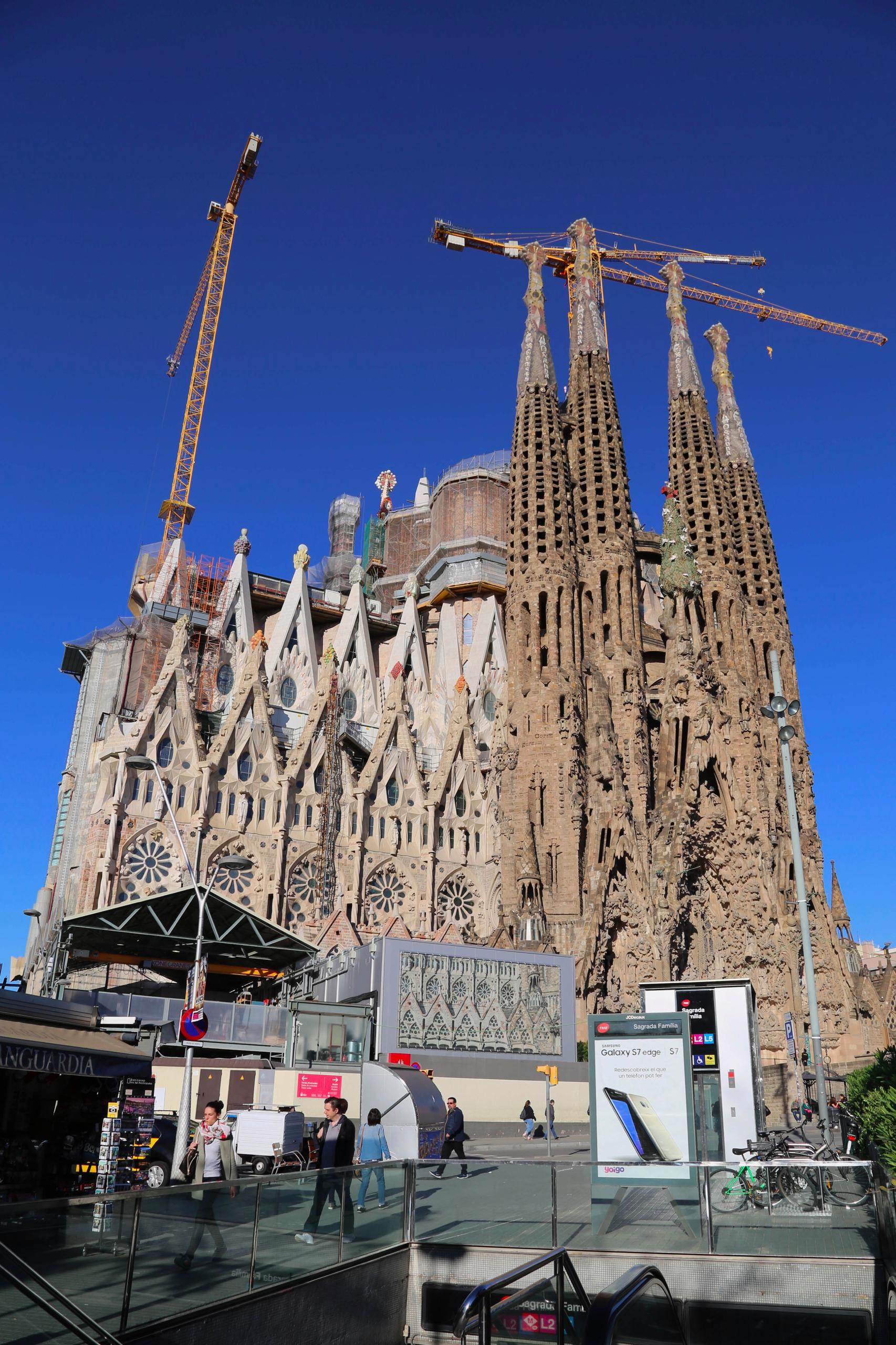
For well over a century work has been underway at Sagrada Familia to complete the dream of one man’s incredible vision.
Barcelona deserves its reputation as one of the world’s top travel destinations, a city with a grand mix of history, culture, cuisine, and architecture. When it comes to Barcelona’s architecture, no name is more highly regarded than Antoni Gaudi. His singular style of design has bequeathed the city some of the most recognizable buildings on the planet and the pinnacle accomplishment of the Catalonian’s “labore corporis” is Sagrada Familia.
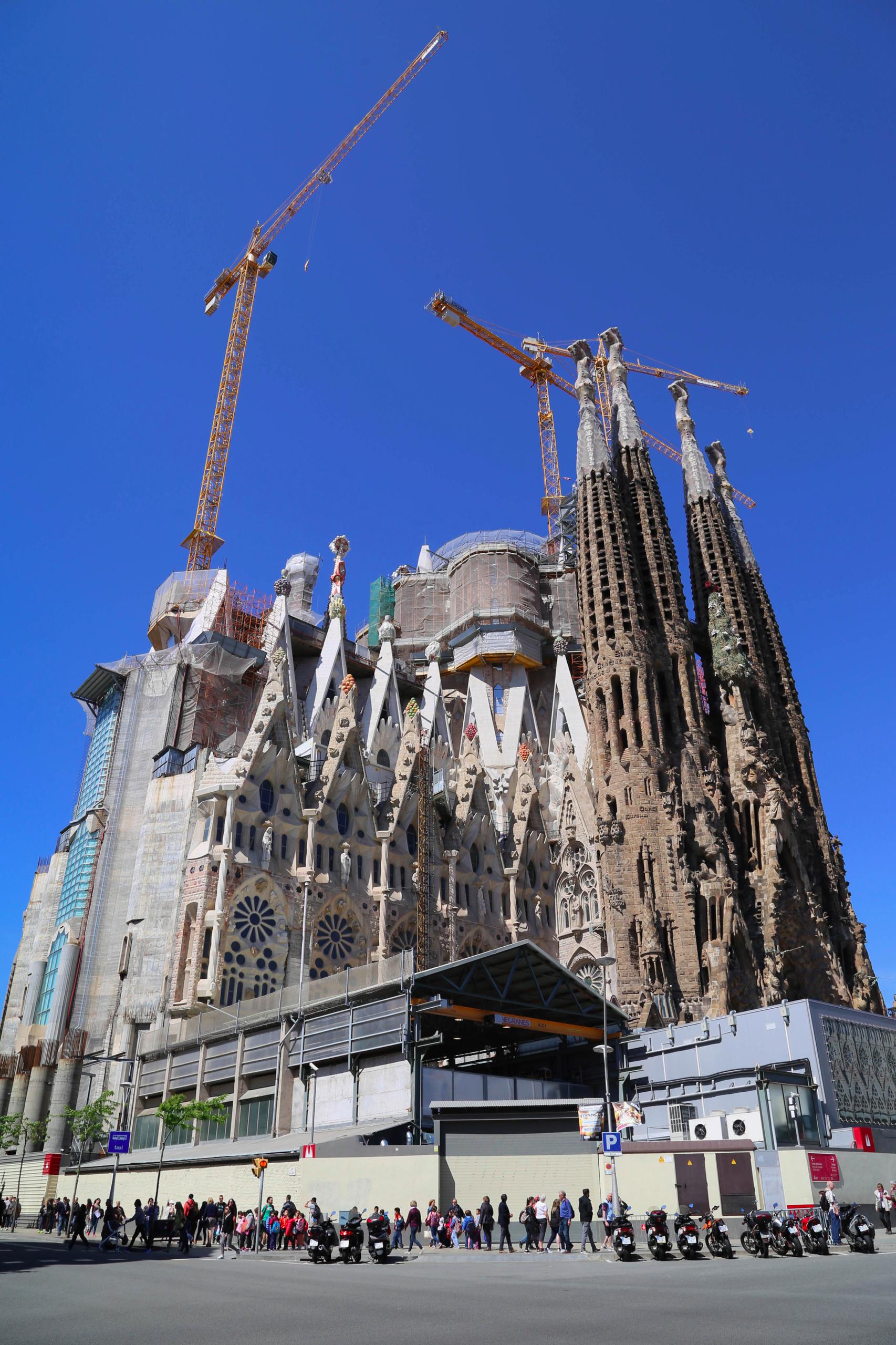
Work at the famed basilica has been underway since the cornerstone was laid in 1882. Officials expect work to complete by 2026.
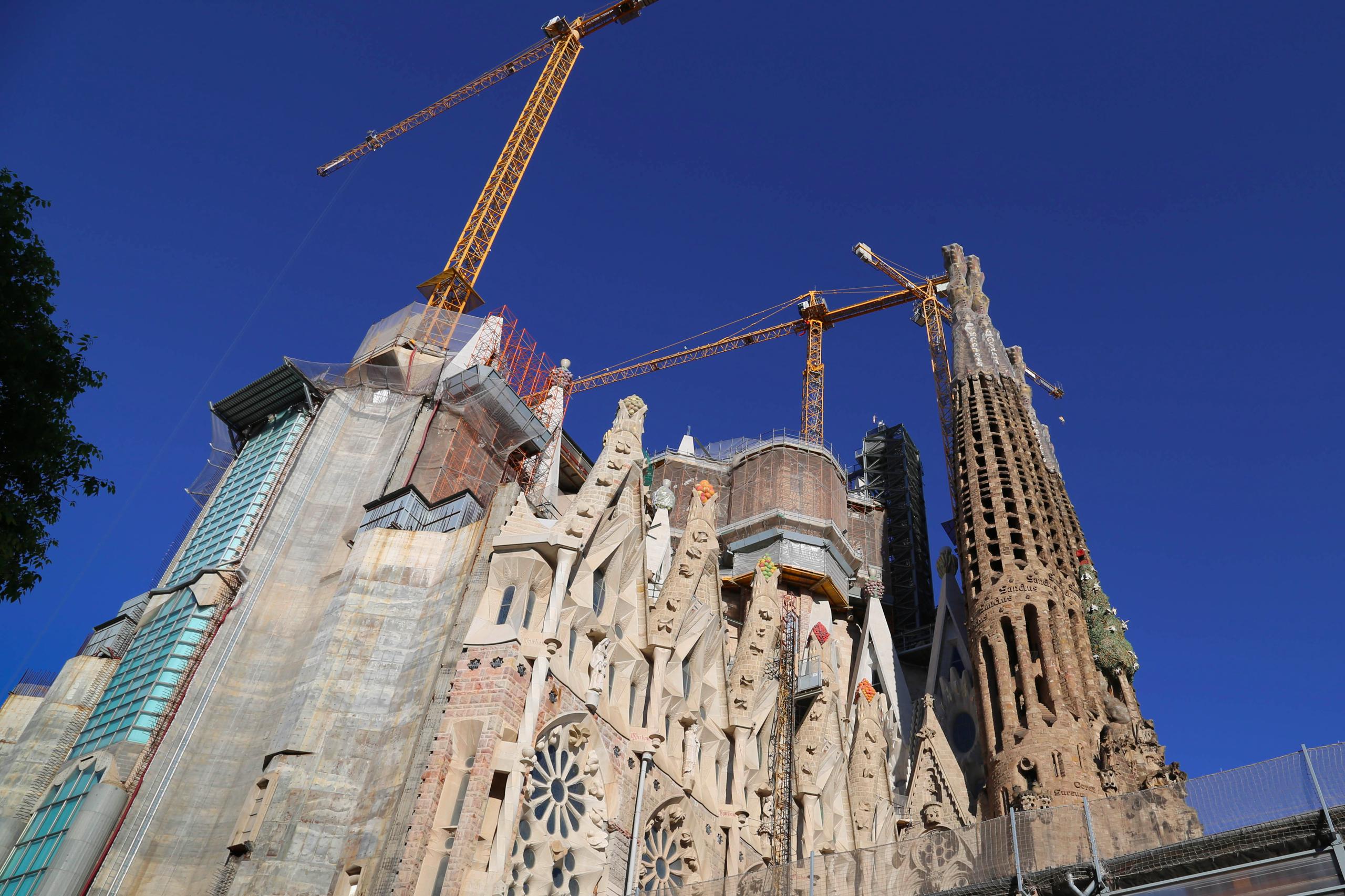
It is difficult to grasp the complexity of the design and engineering of Sagrada Familia, and then to realize that all of this was spearheaded by one person — Antoni Gaudi.
The story of Sagrada Faimilia – Sacred Family – and Antoni Gaudi are intertwined. Both the city and the man represent a series of contrasts – and similarities. In some ways each is a product of the other, and neither would be one without the other had it not been for a devoutly religious man’s ambition and a city’s desire to construct a shrine to Catholicism.

A view of Barcelona from inside one of the church spires.
For centuries Barcelona has made its own way in the world. When the region was brought into Spain, more than 500 years ago, the city bordering the Mediterranean balked. After all, Barcelona had been a nexus for commerce and trade long before Spain was a nation ruled by a far-off king. Even today, Barcelona, the major city in Catalonia, continues to be the economic engine of Spain. This is a fact Barcelonans are proud to point out, while the government in Madrid tends to downplay it.

The Passion Facade above the west entryway of the basilica was envisioned by Gaudi but executed by Josep Maria Subirachs beginning in 1986. The austere and sharp angles of the pieces are faithful to Gaudi’s design that is intended to invoke fear.

Shapes and elements of all sorts have a way of blending together in the design of Antoni Gaudi’s creation.
Long before he was nicknamed “God’s architect” Antoni Plàcid Guillem Gaudí i Cornet was born in June 1852, in a small village south of Barcelona, along the coast. He was the youngest of five children and he lived with his family in the village of Reus. Gaudi took great pleasure in exploring the countryside and learning about nature and the world of Catalonia. But his path to world-renowned architect was somewhat circuitous, owing to the times and his overall health.

The well worn spiral staircase descending one of the spires might easily be a metaphor for the twisting path that was Antoni Gaudi’s life and the world famous basilica he envisioned.
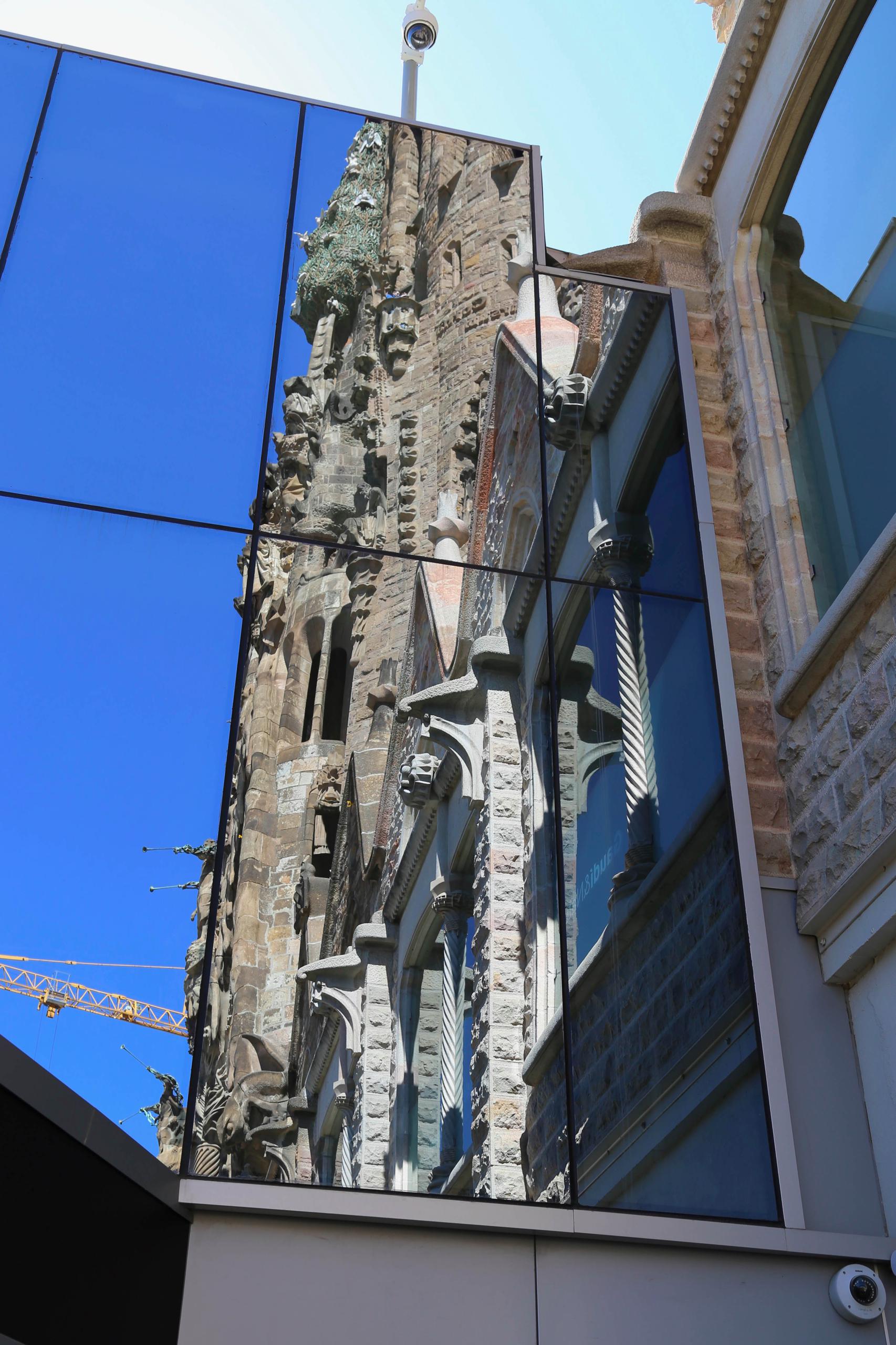
Windows from the more modern visitors center and gift shop reflect some of the facade of Sagradia Familia.
Like all young Spanish men of the day, Gaudi served four years of military duty beginning in 1875. But he was not physically robust, so he spent a good deal of his service on sick leave. He was allowed to enroll in architecture school and graduated in 1878. However, his skill as an architect was in doubt; a professor is reputed to have said, “We have given this academic title either to a fool or a genius. Time will show.” Over the years Gaudi would go on to show both his professors and the world his genius.
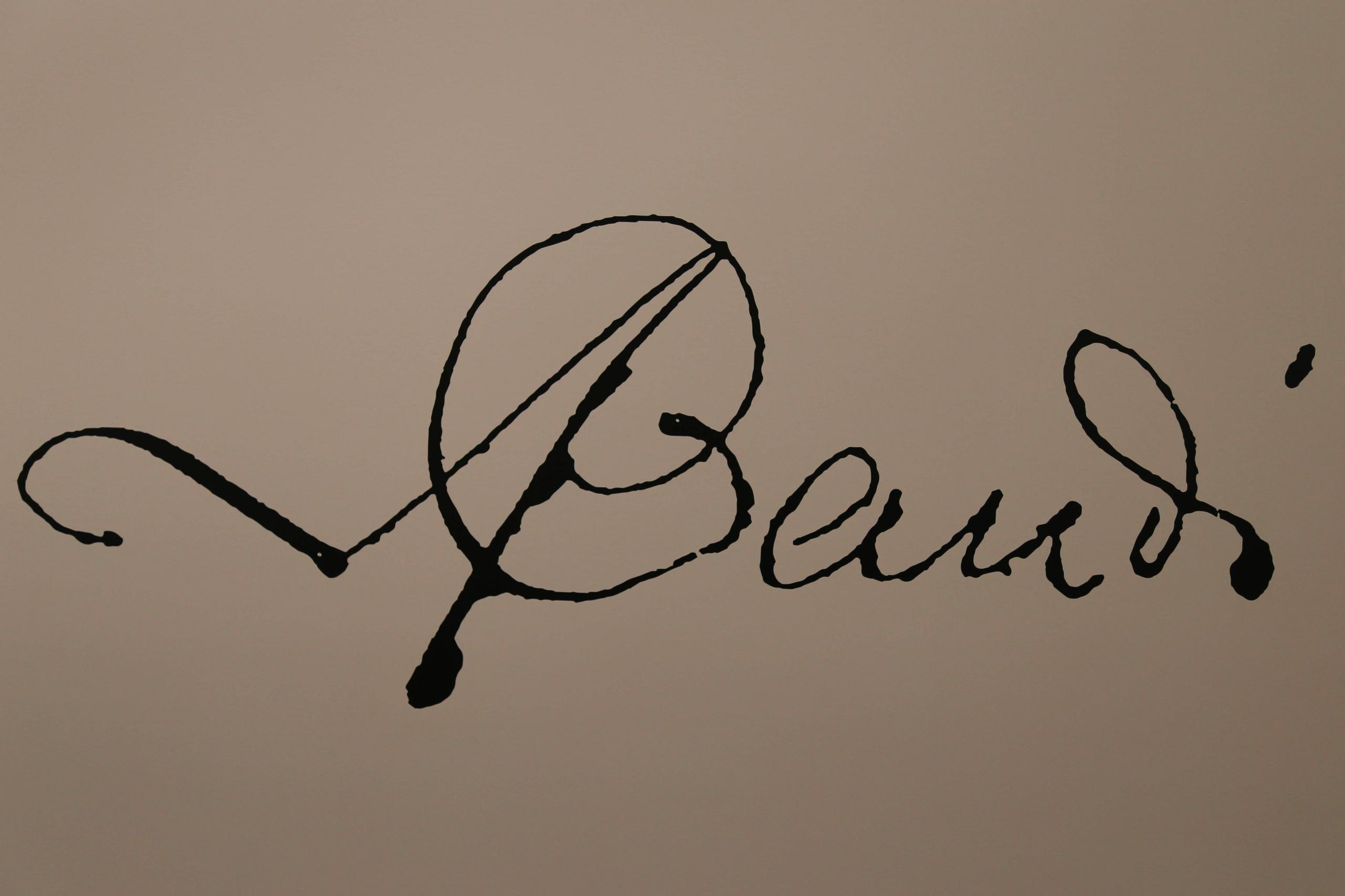
Gaudi’s signature shows boldness and hesitation, but clearly proclaims the name of one of the world’s great architects.
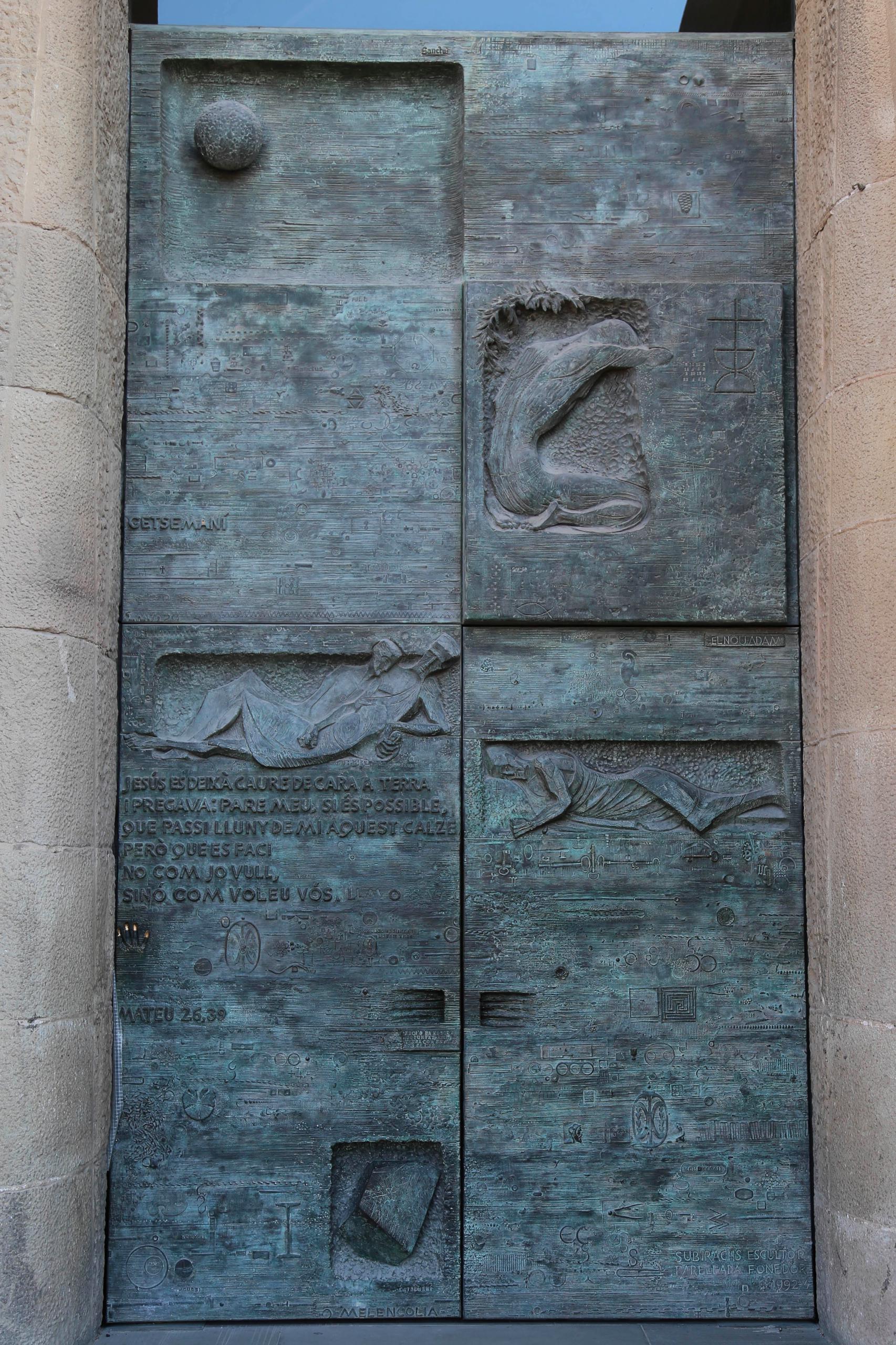
One of the doorways at Sagrada Familia is filled with biblical references.

There is a lot to see and take in during a visit to Sagrada Familia because everywhere you turn you see something as beautiful as this.
Gaudi was a contrast of humility and ambition. His reserved manner is thought to have been due to years of poor health, including rheumatism. He never married and had only one serious relationship, with a woman who ultimately spurned him. But professionally the creativity of his design and a desire to go beyond the norm caught the eye of patrons and clients, including industrialist Eusebi Guell.
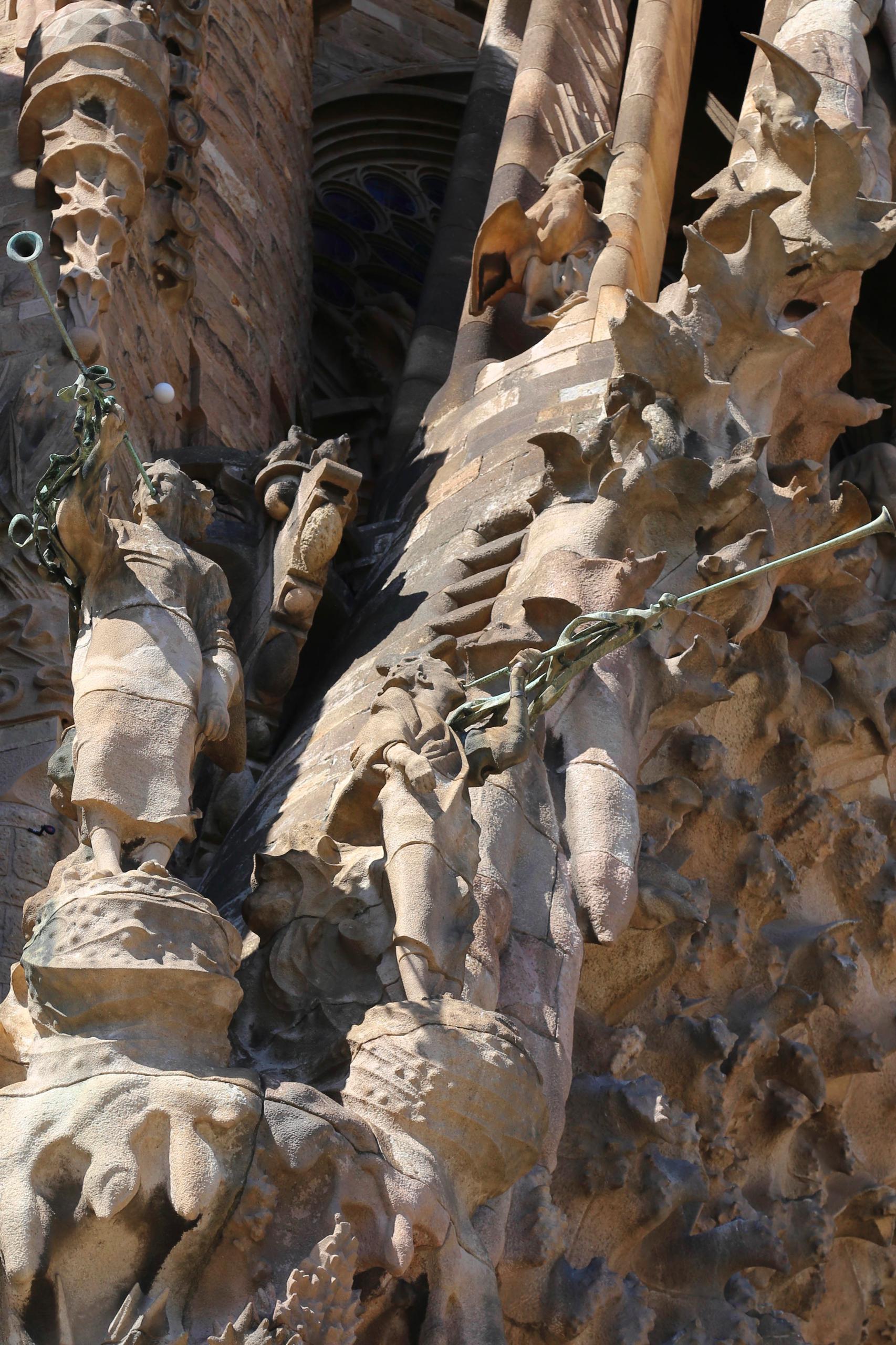
Trumpets blare in this small detail of the Nativity Facade on the east side of Sagrada Familia.

Antoni Gaudi had a deep love of nature and the columns inside Sagrada Familia are meant to be like the trees in a forest.
Gaudi’s name is synonymous with Sagrada Familia but he was not the project’s original architect. Francisco de Paula del Villar y Lozano was chosen and his plan was to build a church in a Neo-Gothic style; the cornerstone was laid in 1882. But soon Villar was squabbling with his patrons. Gaudi, who had been hired in 1882 to design the crypt, replaced Villar as chief architect in 1883. Although it took another six years for him to complete work on the crypt, the extra time enabled the development of new ideas that would radically alter the look of Sagrada Familia. Those new ideas fell under the umbrella known as Modernism (or Modernisme to the Catalans).
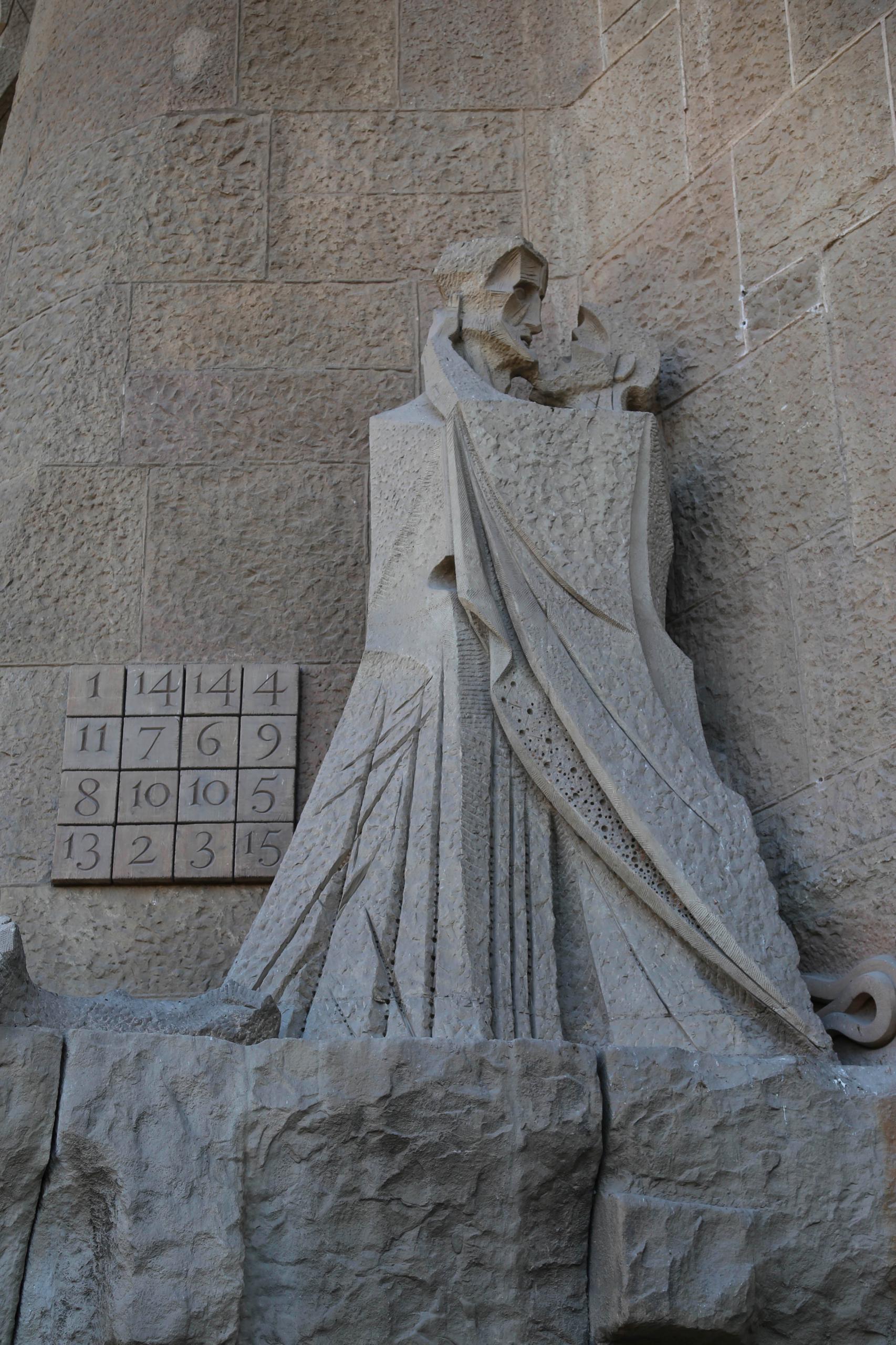
The cryptogram at this facade shows Gaudi’s creativity and devotion. Add any row of numbers in a straight line and you get the same answer — 33 — the age when Jesus Christ was crucified.

The Passion Facade, constructed years after Gaudi died, reflect a more angular and starker portrayal of stories from the Bible.
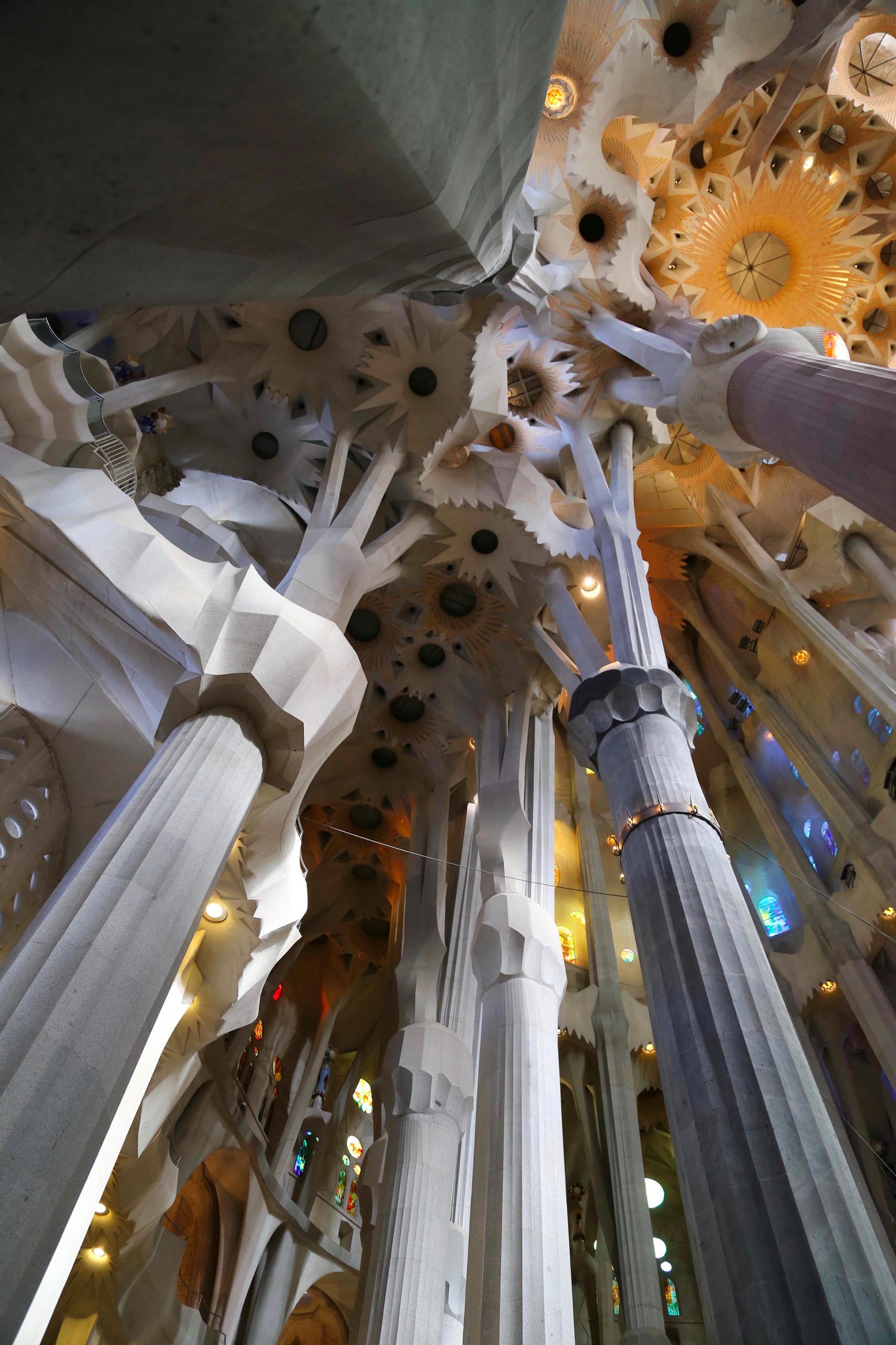
This is an excellent example of Gaudi’s use of engineering and aesthetics to produce strength, volume, beauty, and harmony.
Like so many revolutions, Modernism rejected what came before and Gaudi embraced these new ideals. For Gaudi, Gothic and Neo-Gothic architecture were restrictive and did not embrace the natural, living aspect of the world, resulting in something forced. Modernism went beyond rigid formulas and straight lines and integrated the arts, design, and construction to create more fluid and natural results. By the time he finished his work on the crypt in 1889, Gaudi was advocating a wholly new design for the church.
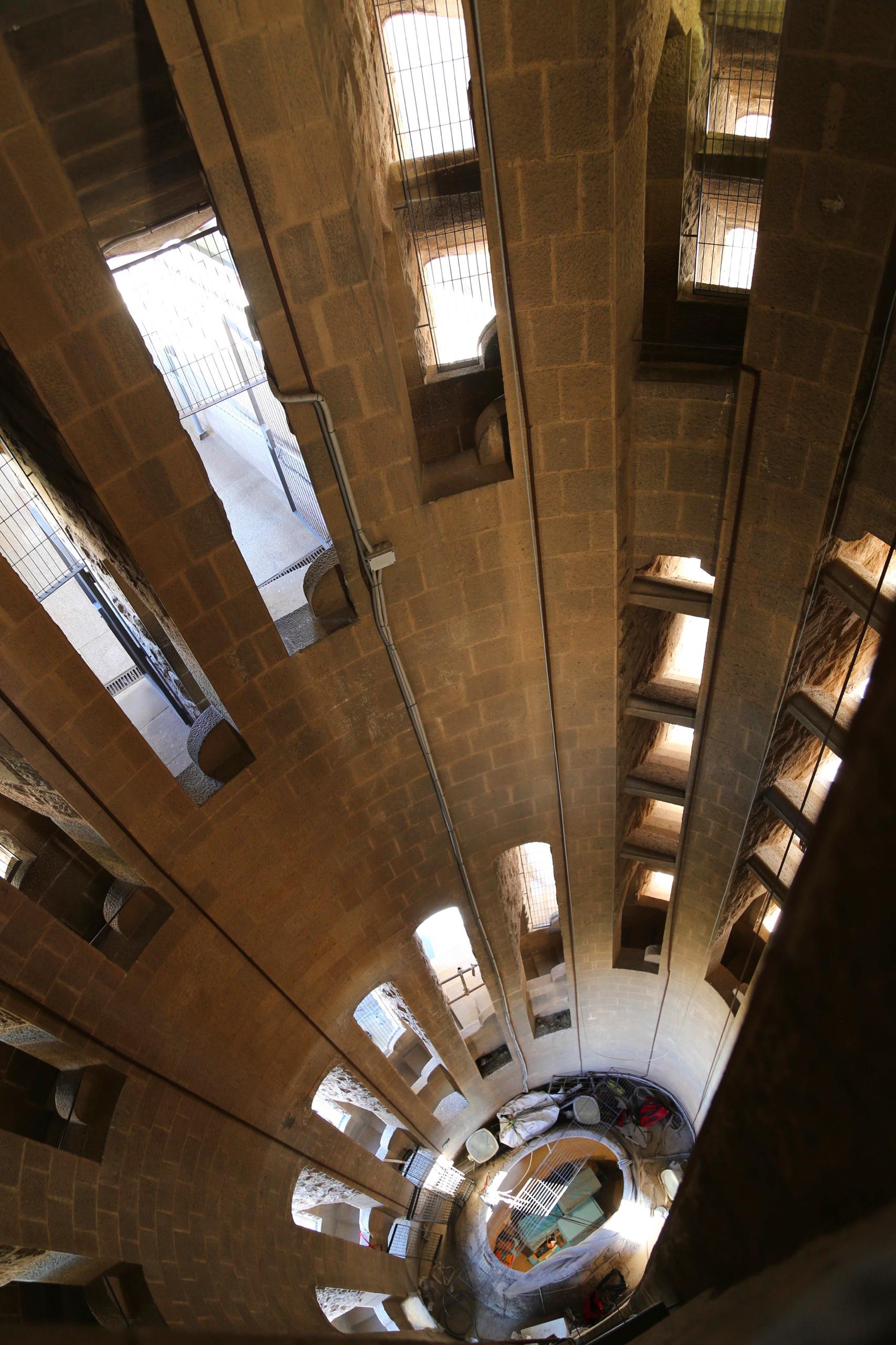
The tapered spires outside Sagrada Familia are hollow, with openings to light the way.

Until an elevator was installed a few years back, visitors had to be in good shape to walk up these stairs before they could go down. But the views to the city make the journey — and slightly added expense — worth it.

From inside the spire one can catch a glimpse of an element looking down at the scaffolding used by construction workers.
The result, still under construction more than 125 years later, is a demonstration of daring. Gaudi designed a house of worship with elements like none other in the world. And knowing Sagrada Familia would never be finished in his lifetime, he wisely chose to construct models of key elements to go along with his drawings so his vision would be adhered to. To make real what Gaudi saw in his mind is as complicated in the 21st Century as it was in the 19th. Today computer-aided design makes it easy to view a drawing from any angle. Lacking that technology, Gaudi took no chances. To be certain builders and craftsmen constructed what he envisioned, Gaudi literally turned mock ups on their head – using small chain link strings, he hung elements upside down to demonstrate how the line of a spire was to appear and how much it should curve. He then placed a mirror below the hanging mock up so builders could see exactly what Gaudi intended.
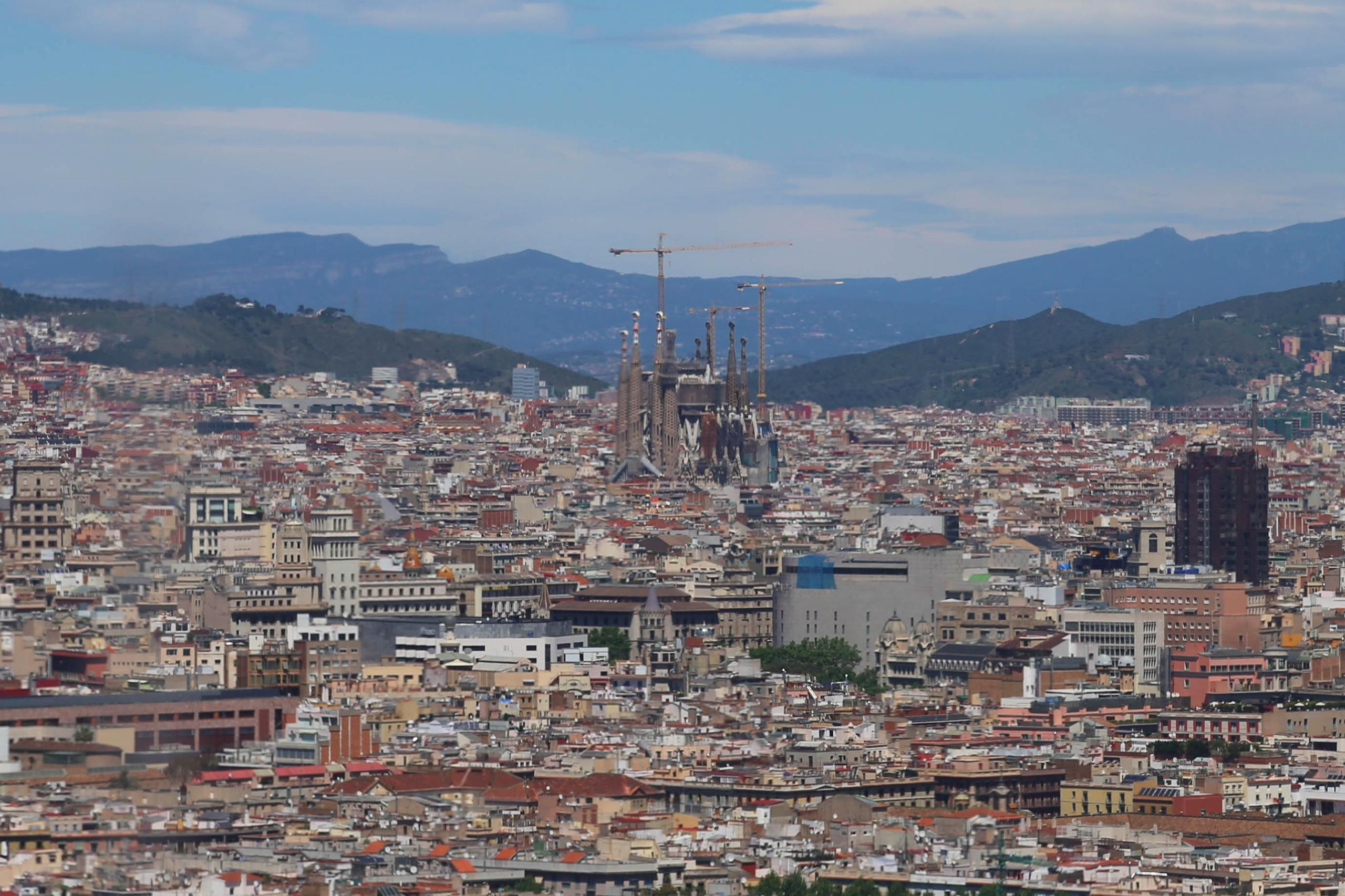
Sagrada Familia is an integral part of Barcelona, one of the world’s great cities.
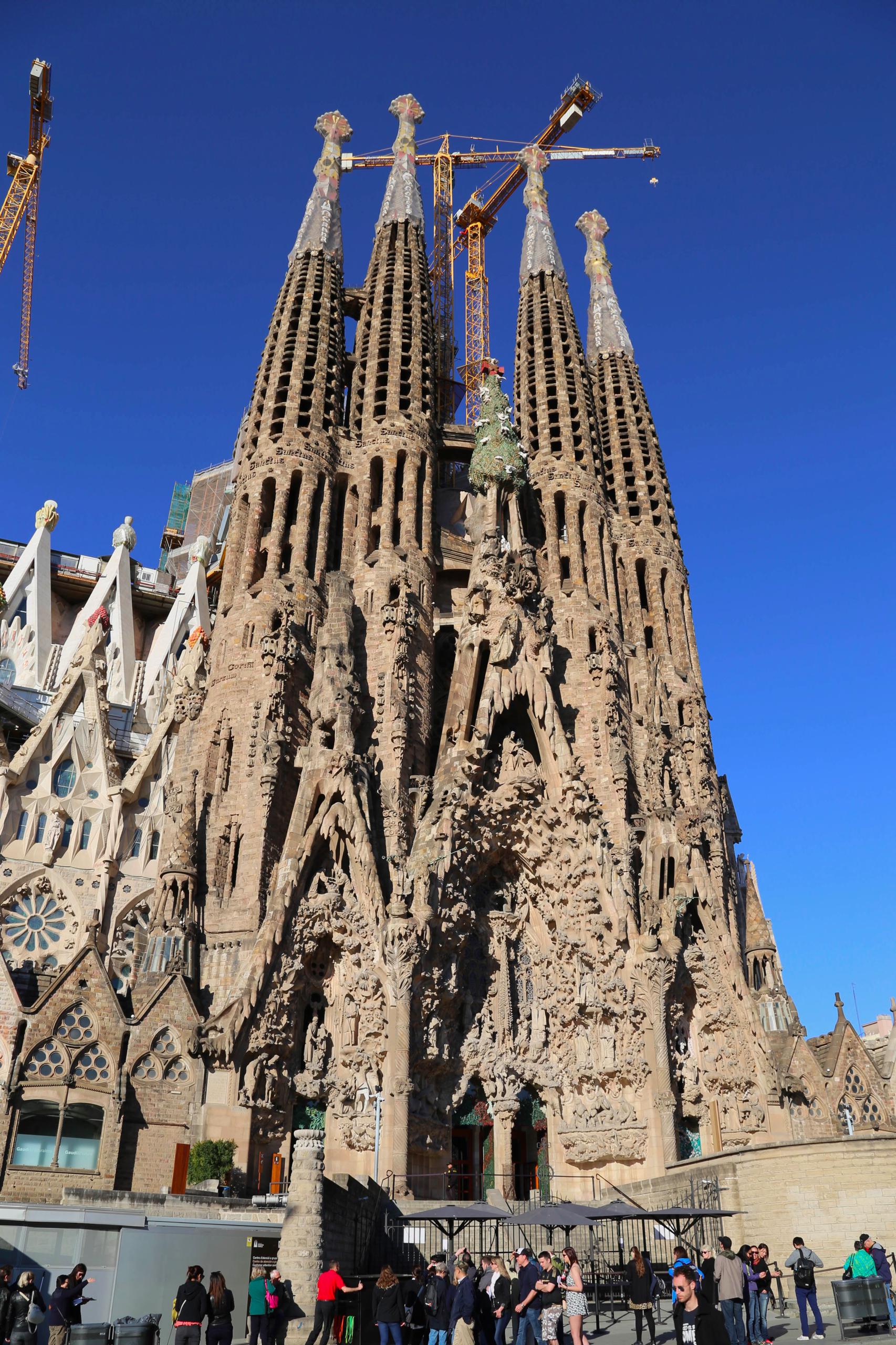
When Gaudi was named chief architect of Sagrada Familia in 1883, he discarded the notion of a Neo-Gothic design and created this design based on the notions of Modernisme.

As sunlight passes through green stained glass and washes over the columns one gets the sense of standing among trees in a forest.
Even from a distance, Sagrada Familia stands as a marvel. Giant tapered spires soar toward heaven, conveying a connection to the spirit of humanity. Gaudi cleverly reduced the weight of the spires and softened their appearance by using columns and openings. The east side of the church – the Nativity Façade – appears from a distance to be a hodgepodge of shapes and iconography but up close stands out as characters and moments from biblical history. Solomonic or barley-sugar-styled columns support the massive stone carvings above. One could easily spend days admiring the carvings and stonework around the outside of the building before venturing inside.
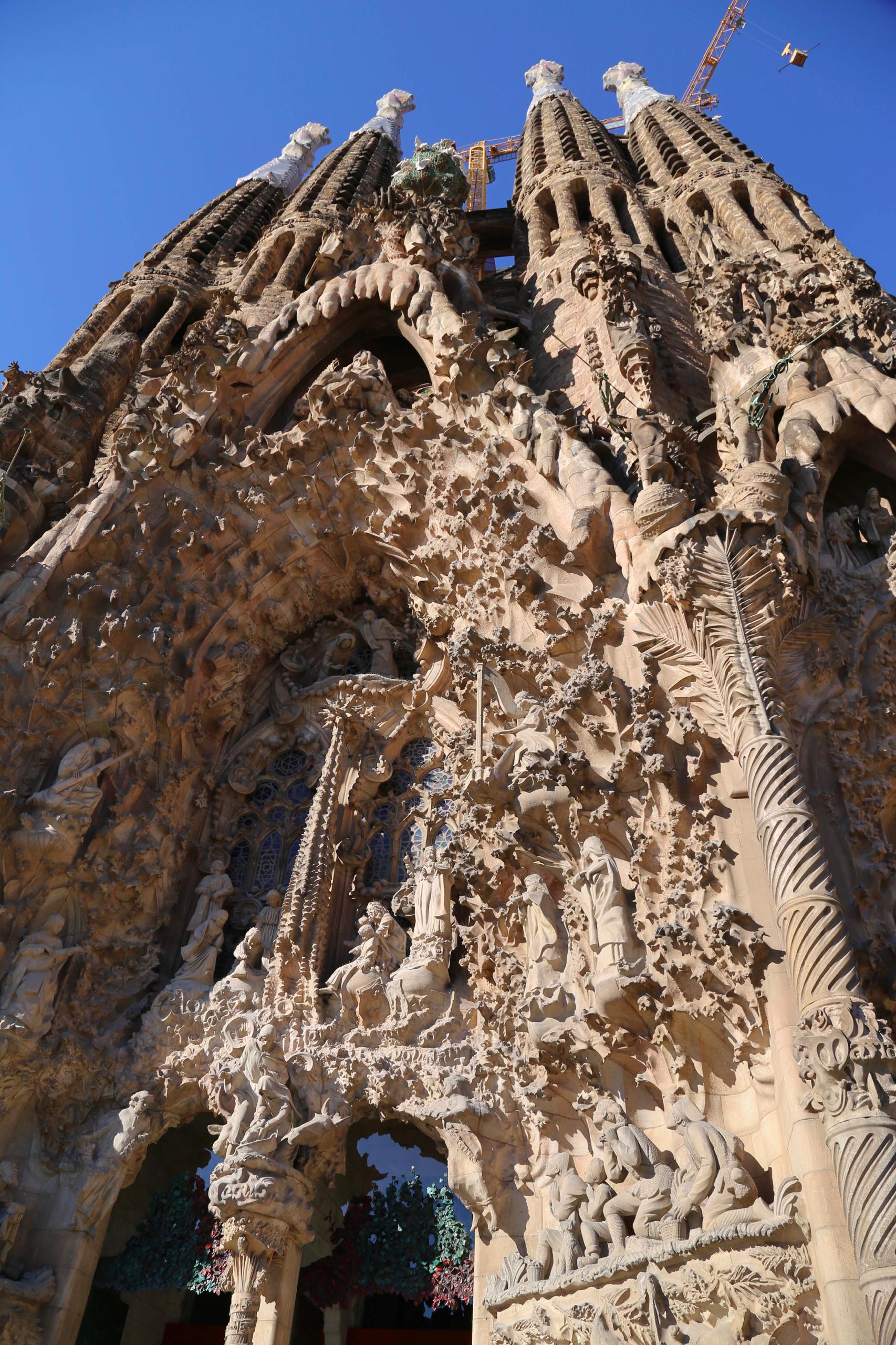
The Nativity Facade on the east side of the basilica depicts stories from the bible.
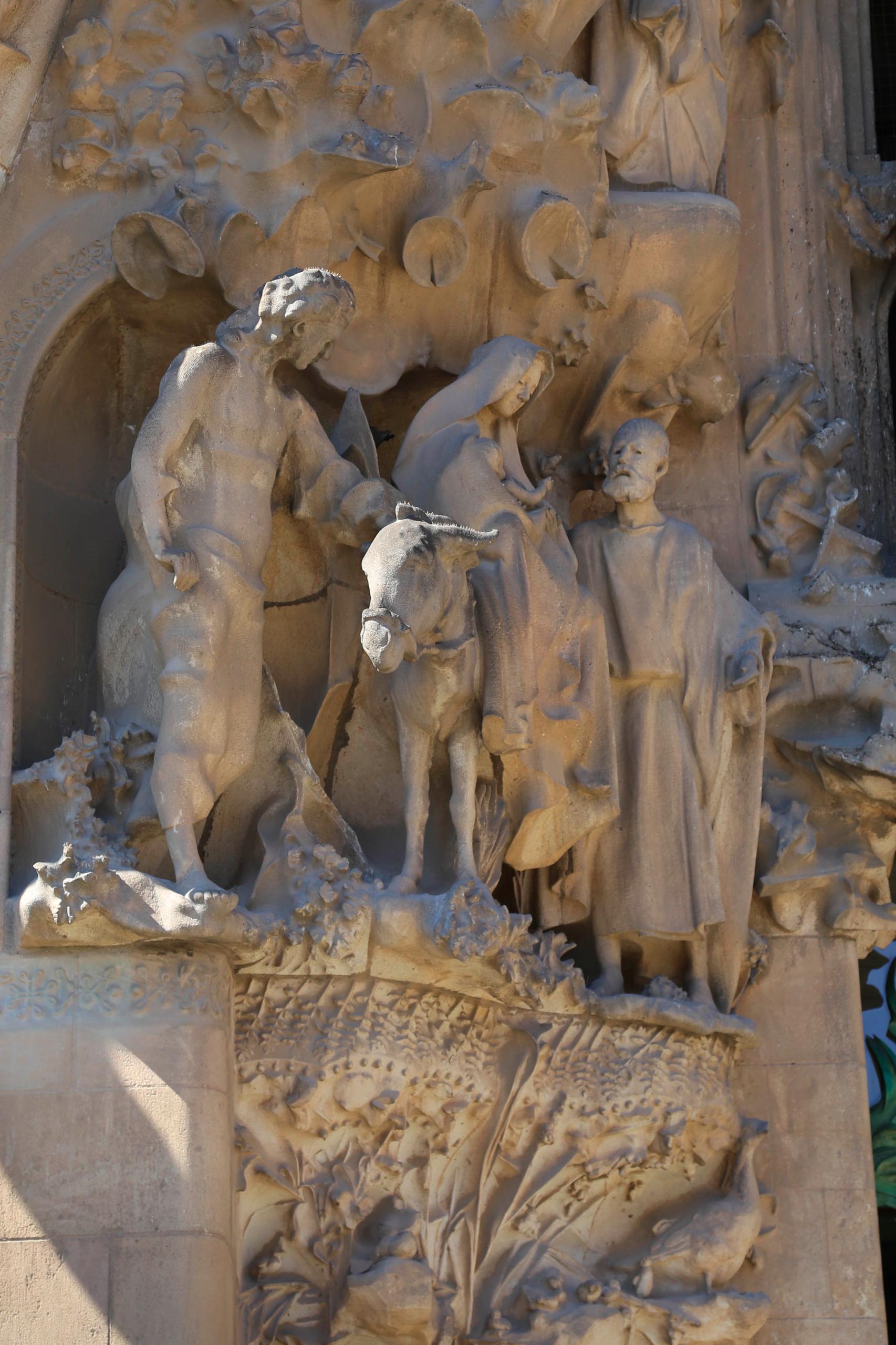
Mary, sitting upon a donkey while cradling her newborn son, Jesus, is accompanied by Joseph, on one part of the Nativity Facade at Sagrada Familia.
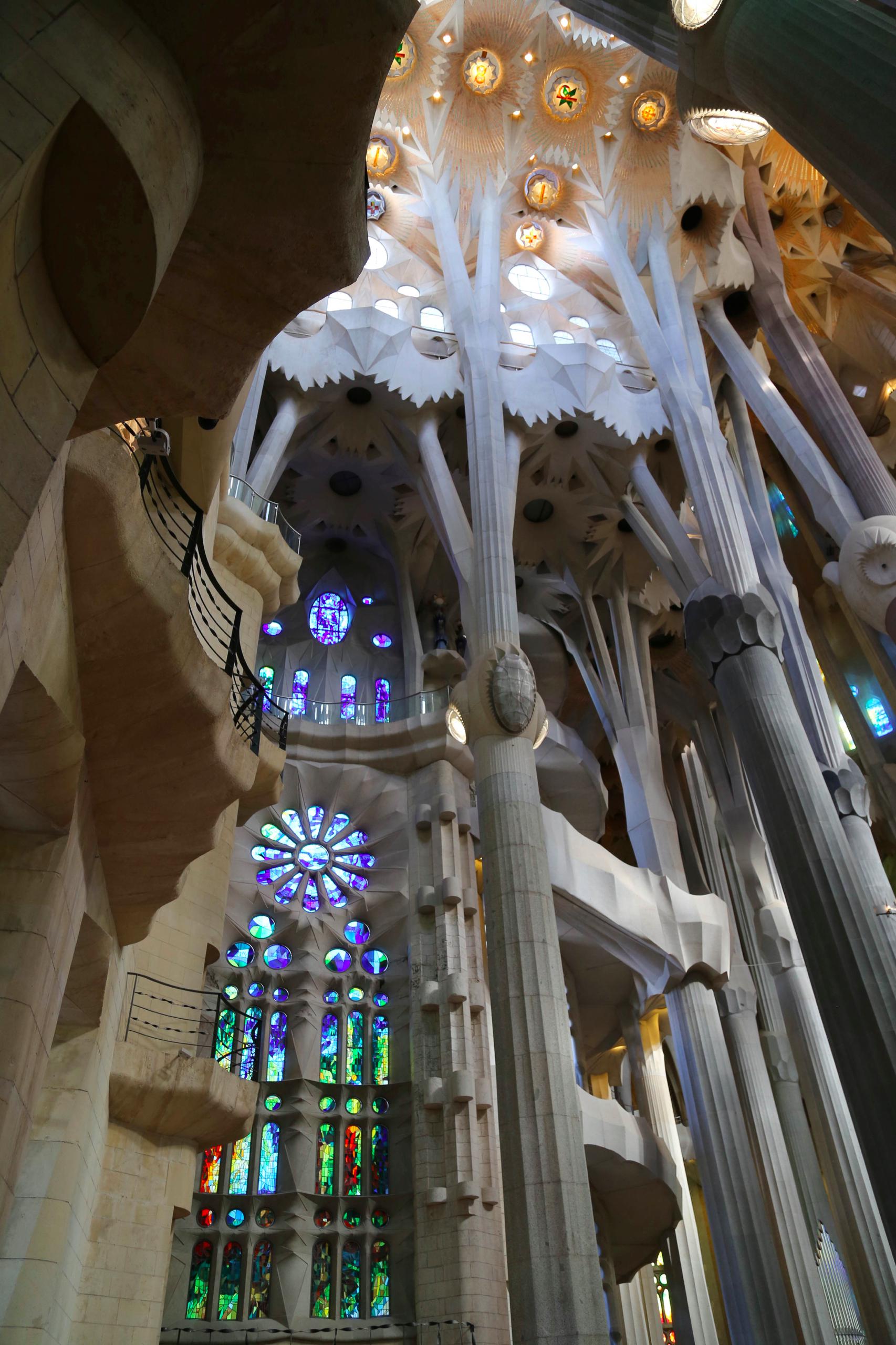
Depending on the time of day the stained glass windows at Sagrada Familia are either dazzling or subdued.
The interior of Sagrada Familia is a wonder to behold. The interior incorporates Gaudi’s embrace of Modernism, his creativity, and love of nature, all infused with his fervent Catholicism. It is a religious building of such grandeur and beauty that there is sometimes confusion about what it should be called. Many people (and news reports) refer to Sagrada Familia as a cathedral, but it is not; a cathedral is a church where the seat of the bishop resides. (The Cathedral of the Holy Cross and Saint Eulalia in the Gothic Quarter is where Barcelona’s bishop is located.) But Sagrada Familia is so highly regarded that in November 2010 Pope Benedict XVI elevated the church to a basilica, granting it special privileges.
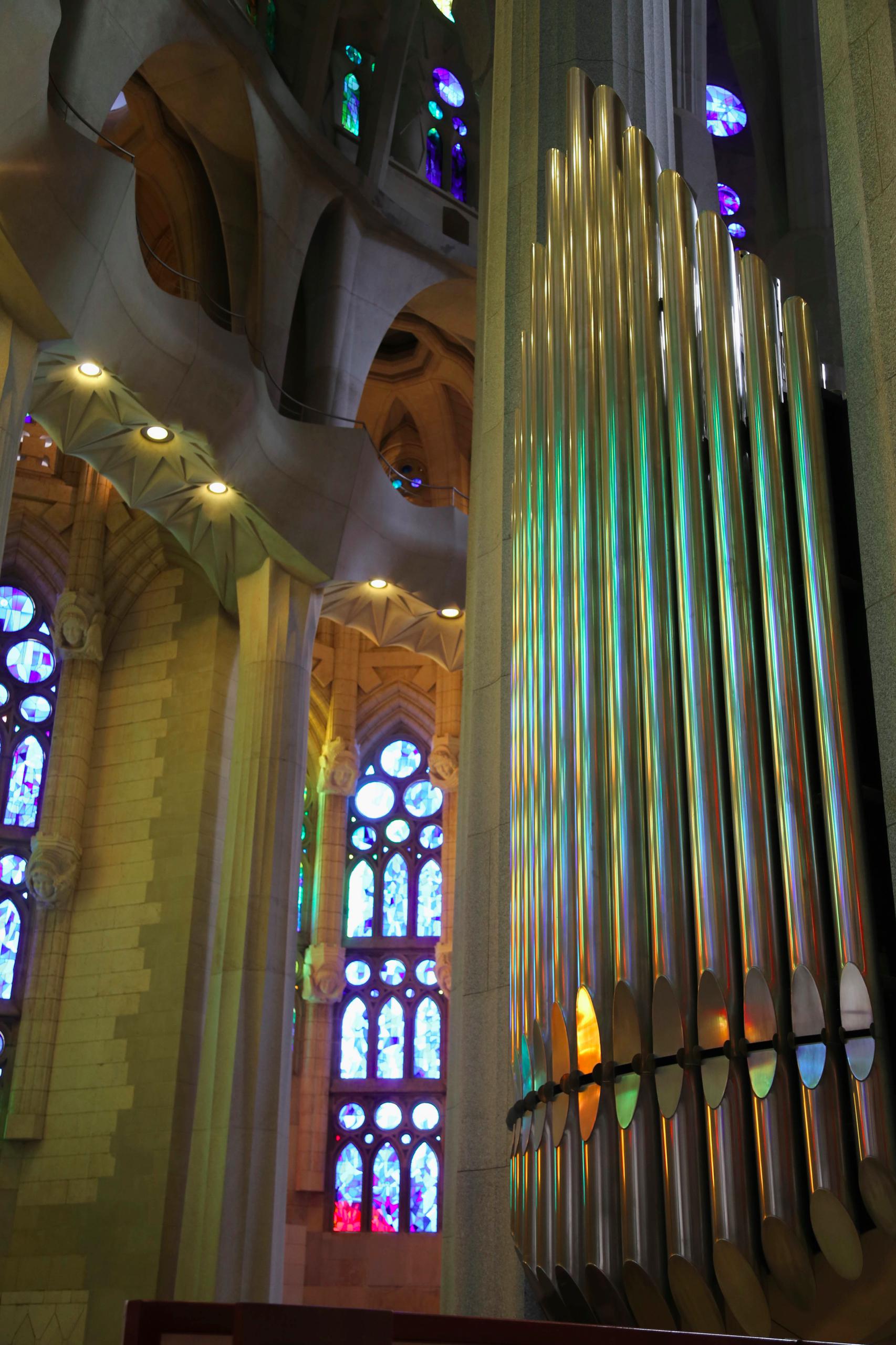
Light from stained glass windows dances across the pipes of the organ inside the basilica.
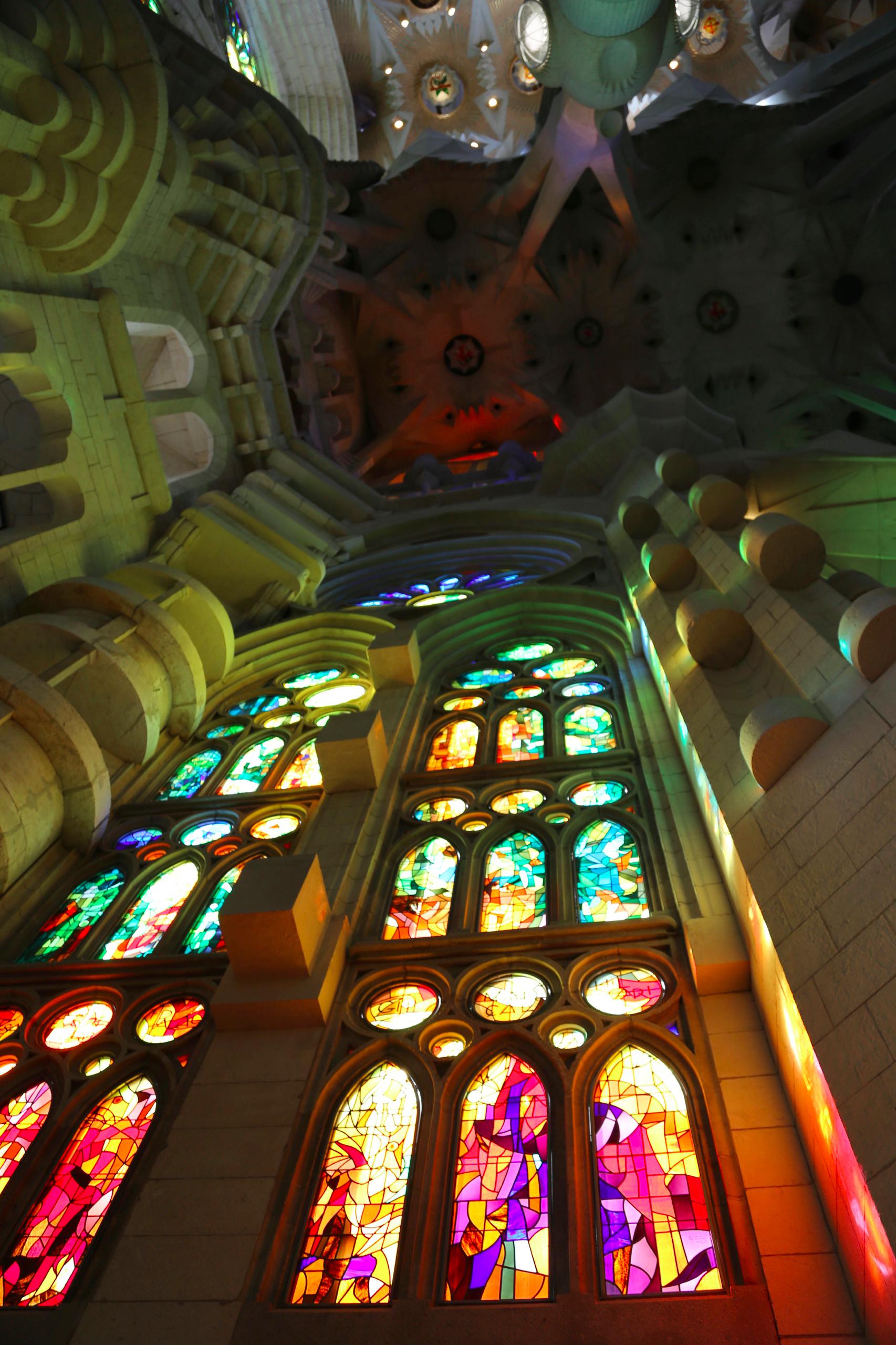
Everywhere inside the basilica is a montage of light and color, thanks to the huge stained glass windows that Gaudi designed.
Gaudi’s spiritual hopes that Sagrada Familia reflected his love of God sometimes created conflict with the realities of design and engineering. An area of potential conflict was the height of the building and size of the columns needed to support the roof. Standard columns – Dorian, Ionic, or Corinthian – would be so huge that they would crowd out the interior space. In typical fashion, Gaudi went in an entirely new direction to solve this problem. He turned to the beauty and efficiency of nature and combined that with skillful engineering. The result is a breathtaking – and still revolutionary – design of interior columns.
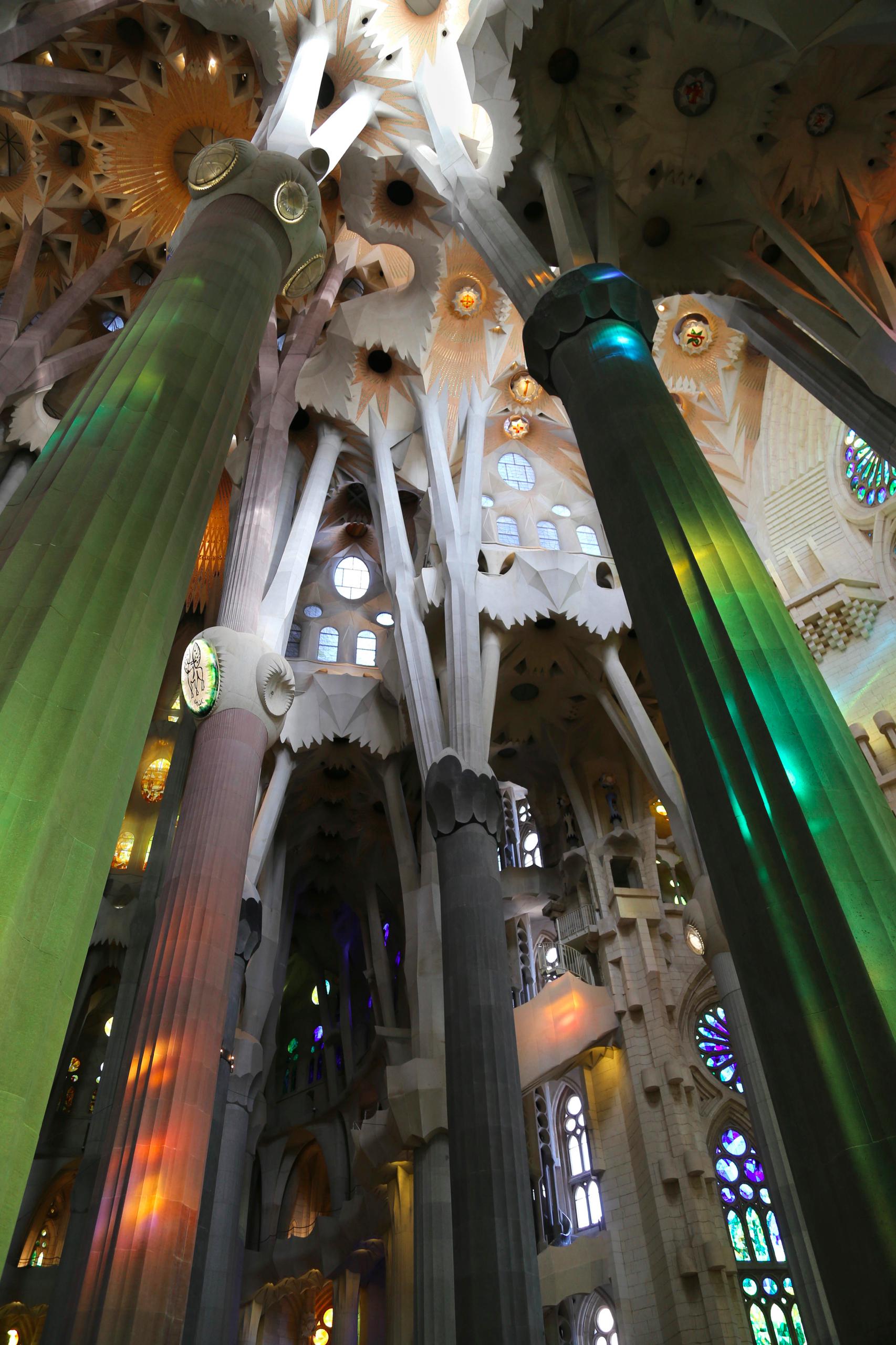
Gaudi’s multifurcation of columns was inspired by nature, like limbs spreading from a tree trunk that soar ever higher.
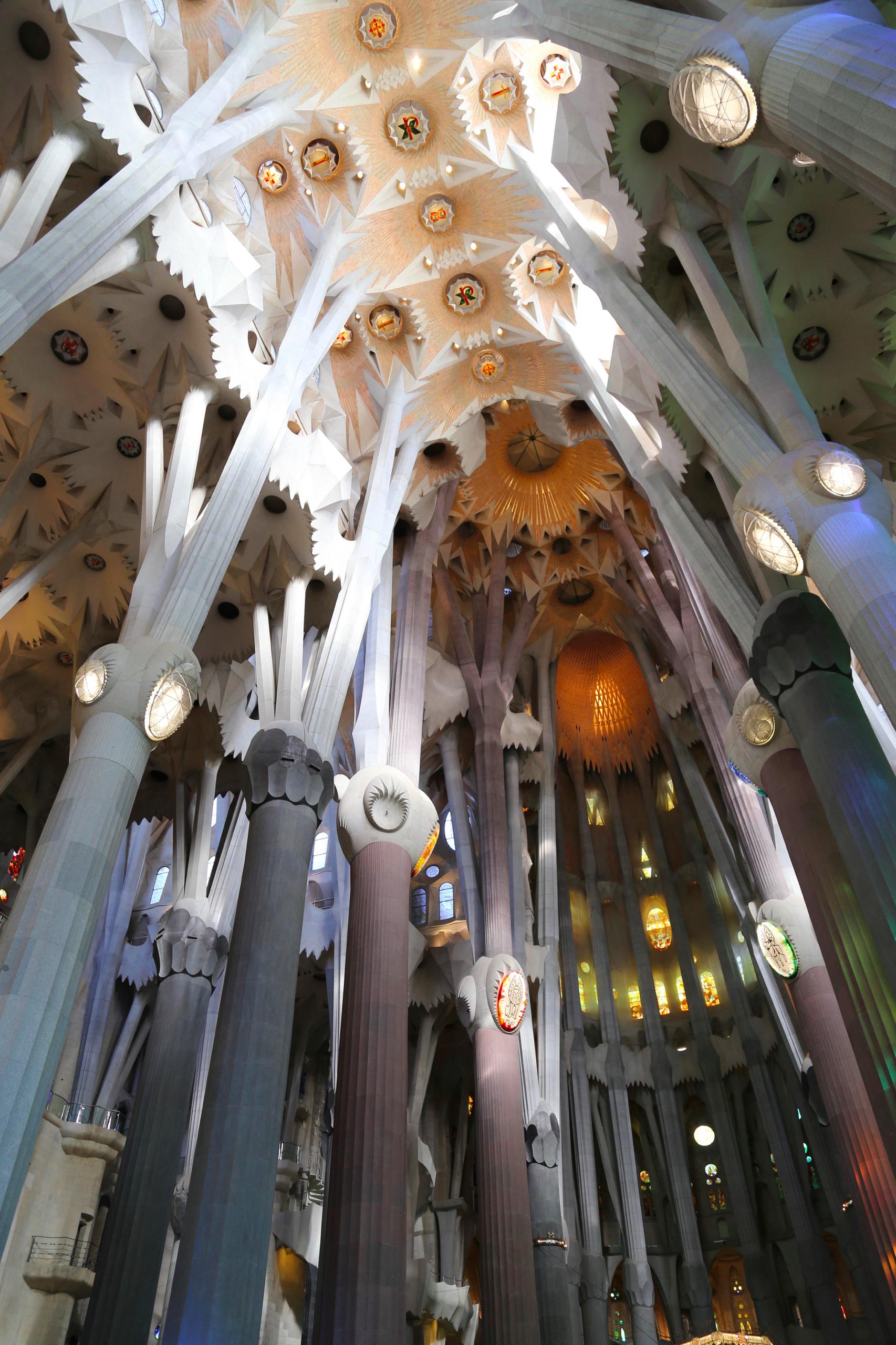
As the columns branch, lean, and reach, the design supports the roof, while preserving the soaring space of the church.
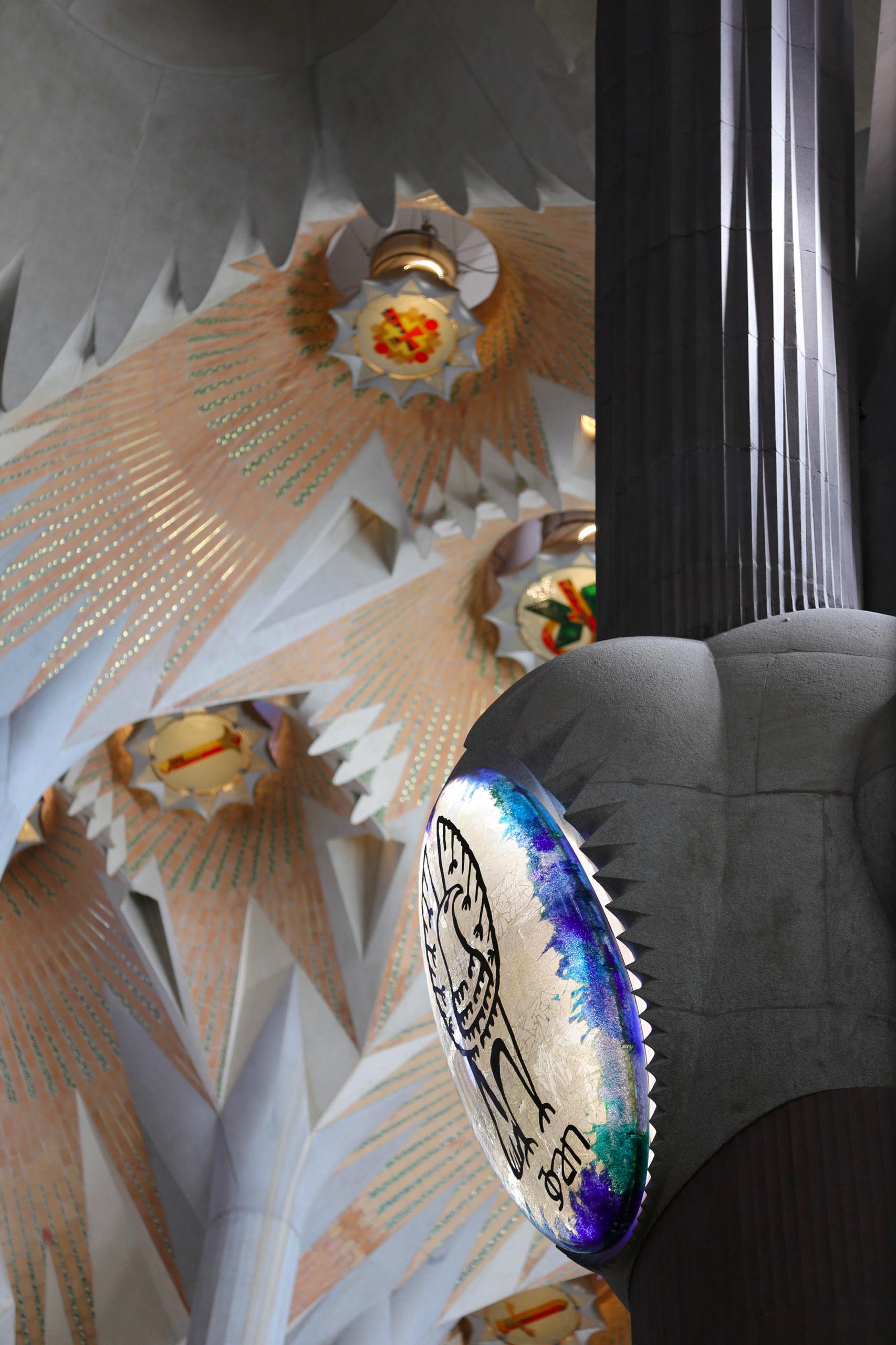
The elements at the top of the column are meant to replicate a knot in a tree where limbs have fallen off and branches bifurcate as the tree grows higher. Note the ever-gentle twist in the column design, allowing for slender yet sturdy support.
Gaudi’s columns feature several brilliant elements. They employ a gentle, subtle twist that allows for a more slender column. His columns utilize multifurcation, mimicking the branching of trees as they stretched upward, at the same time creating more open space and pushed the roof ever higher. Buttressing the beauty and harmony of the interior space is Gaudi’s reliance on consistent mathematical formulas and ratios that maximize height, width, space, and openness. (For example, a number of elements and areas of Sagrada Familia are divisible by 12, both a neat arrangement as well as homage to the Apostles of Jesus.)
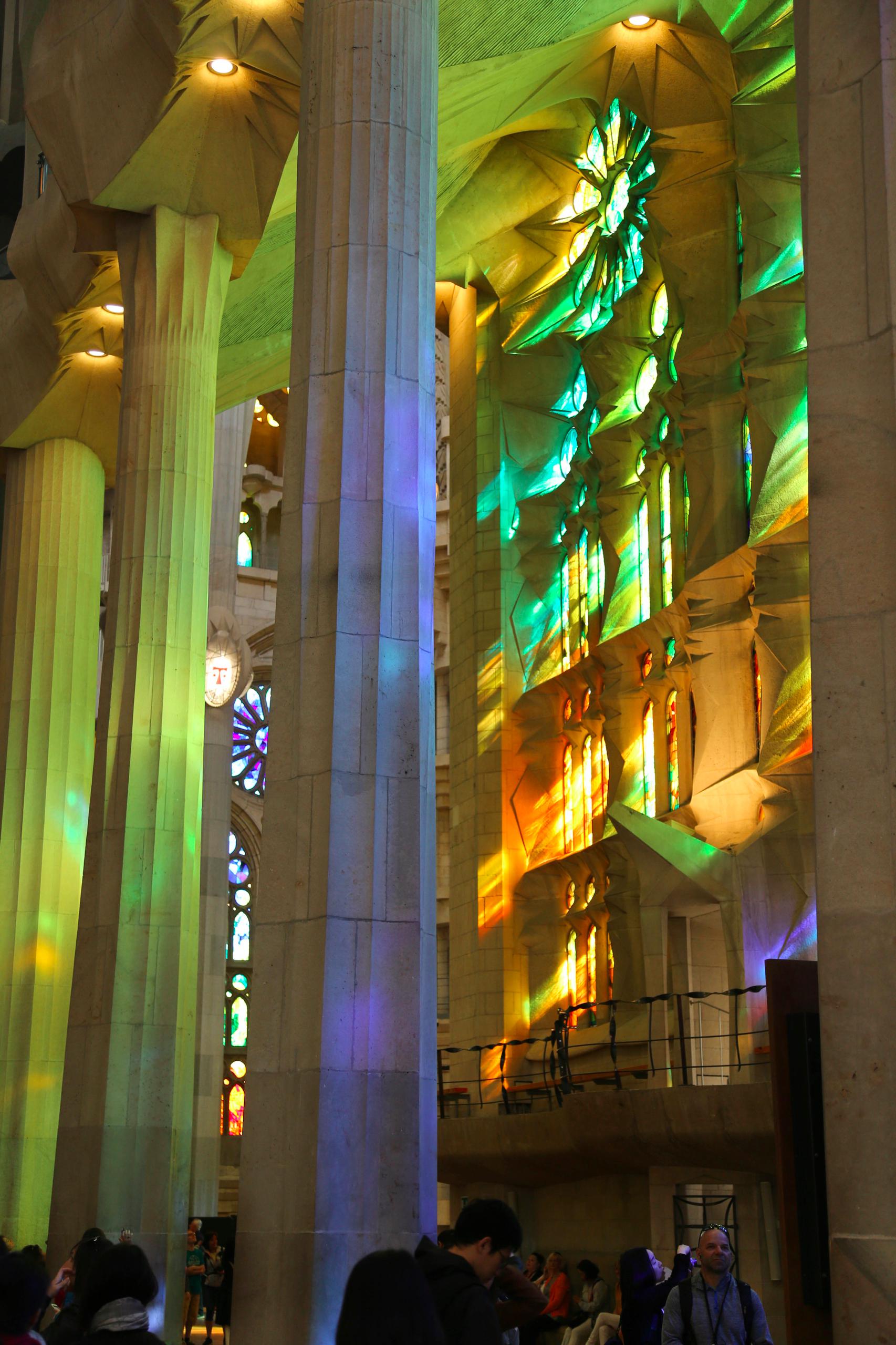
The light from the stained glass windows is one of the inspiring elements of Sagrada Familia,

A wash of color in a rainbow of hues fills this space inside Sagrada Familia. As the sun changes position the space is illuminated with a new palette.
Another equally impressive element of the basilica is Gaudi’s use of light and stained glass. He designed the walls to include huge areas of glass so when light passed through the space inside would be bathed in a warm glow of soft colors. The light from the stained glass dances and reflects off so many places that visitors become mesmerized. It is another example of Gaudi’s integration of the natural and spiritual worlds.
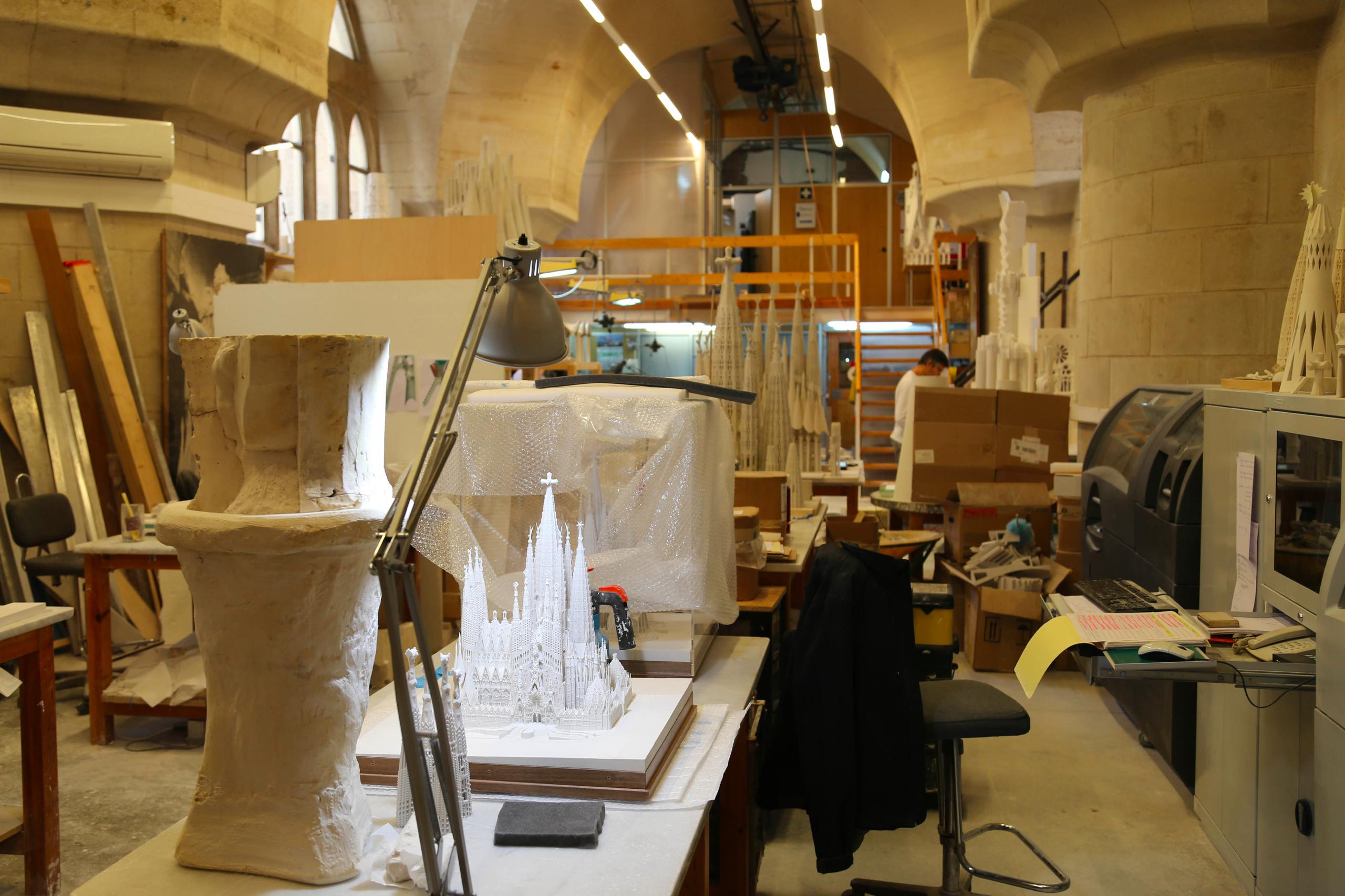
This workshop is essential for the designers, engineers and workers who labor to replicate Antoni Gaudi’s grand vision.

Though reduced in scale, this model of the Sagrada Familia holds many challenges for the dedicated team working to complete the project.
To assist Gaudi, his engineers, and the craftsmen, a huge workshop now in the basement of Sagrada Familia was built that is still in use today. Models of various elements are constructed so the math, angles, and engineering can all be worked out to reflect Gaudi’s inspiration. But the Catalan knew his dream would take longer than his lifetime to complete. Gaudi was so committed to putting as much time as possible into Sagrada Familia that toward the end of his life he slept on a cot at the site.
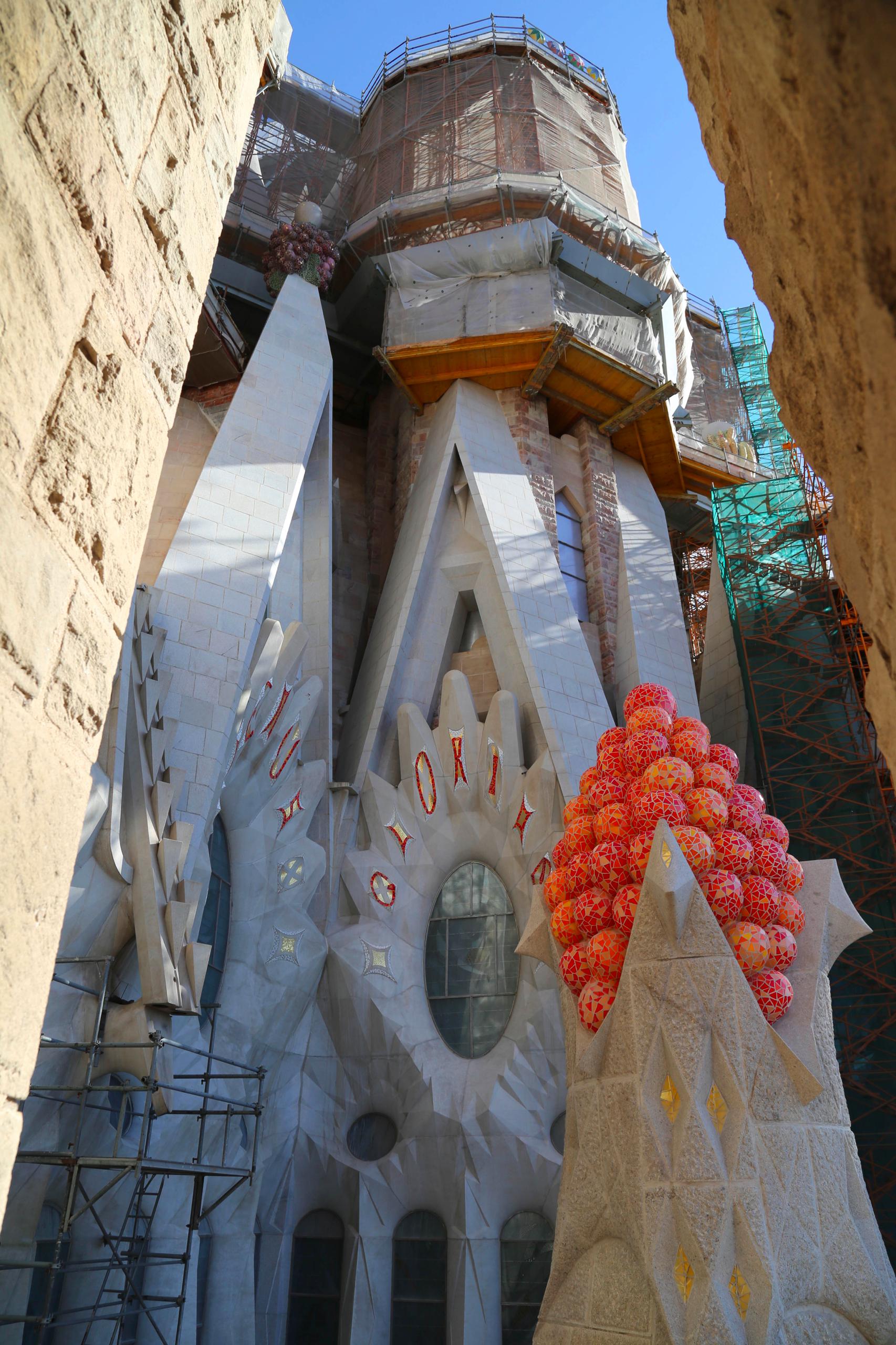
The Gloria Facade, on the south side is being built in accordance with Gaudi’s vision. When completed it will be the main entryway to the church.
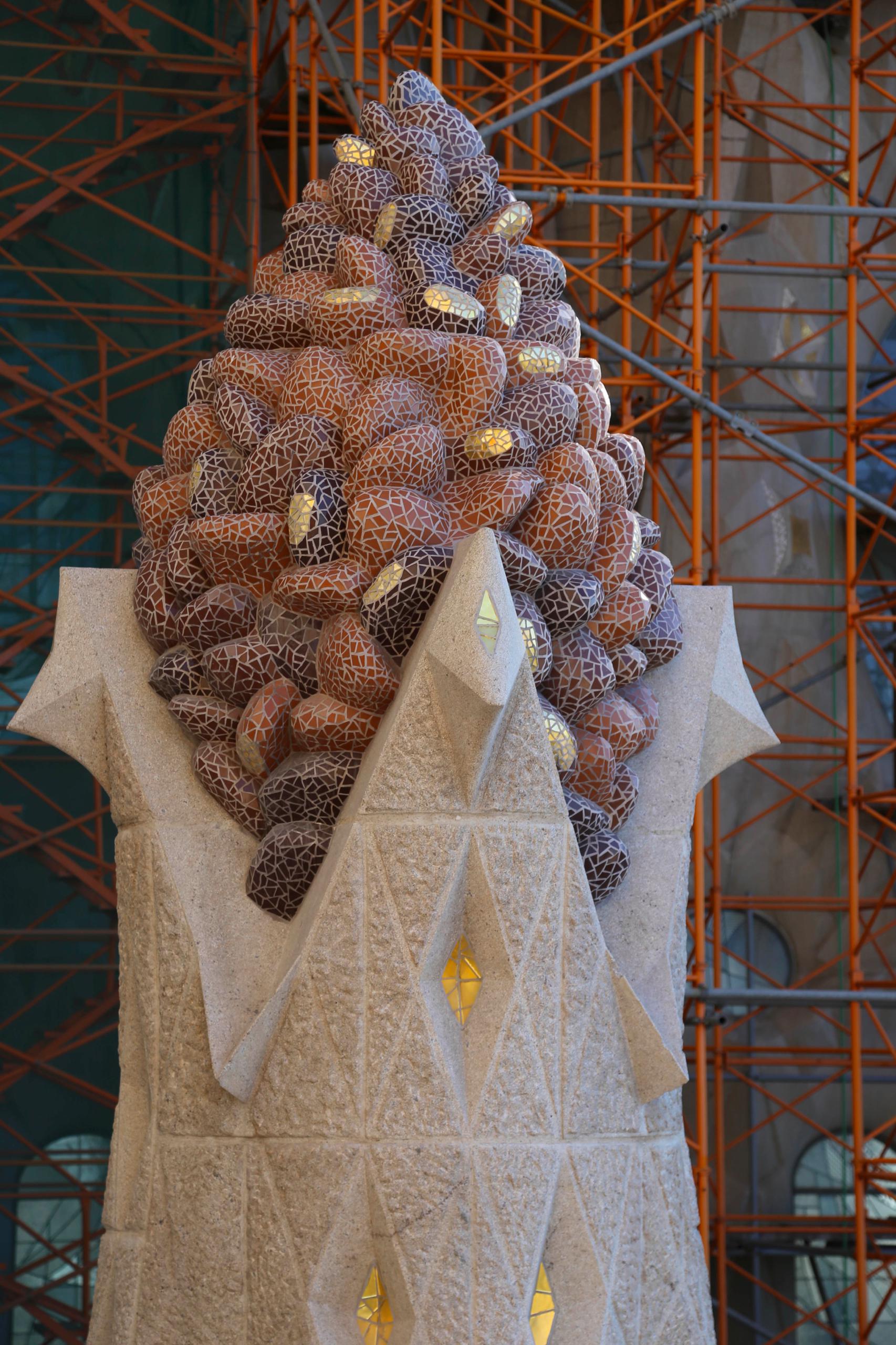
While modern methods are used to complete the task of building Sagrada Familia to Gaudi’s specifications, there are no shortcuts. The tile work on this accent piece demonstrates the great care being taken to adhere to Gaudi’s design.
As the years wore on, Gaudi became increasingly ascetic and his focus became his work on Sagrada Familia. As mentioned earlier, he never married. He did not drink alcohol or eat meat, and would on occasion undergo extreme fasting to purify and cleanse his soul. He went to mass and confession every day and he prayed regularly. Later in his life he became scraggly and unkempt and he cared more about his work that how he looked. In fact, it would be his disregard for personal appearance and his piety to God that would bring about the end of his life.

Antoni Gaudi was passionate about his Catholic faith. Every day he went to mass as well as confession. This crucifix hangs above the altar at Sagrada Familia.
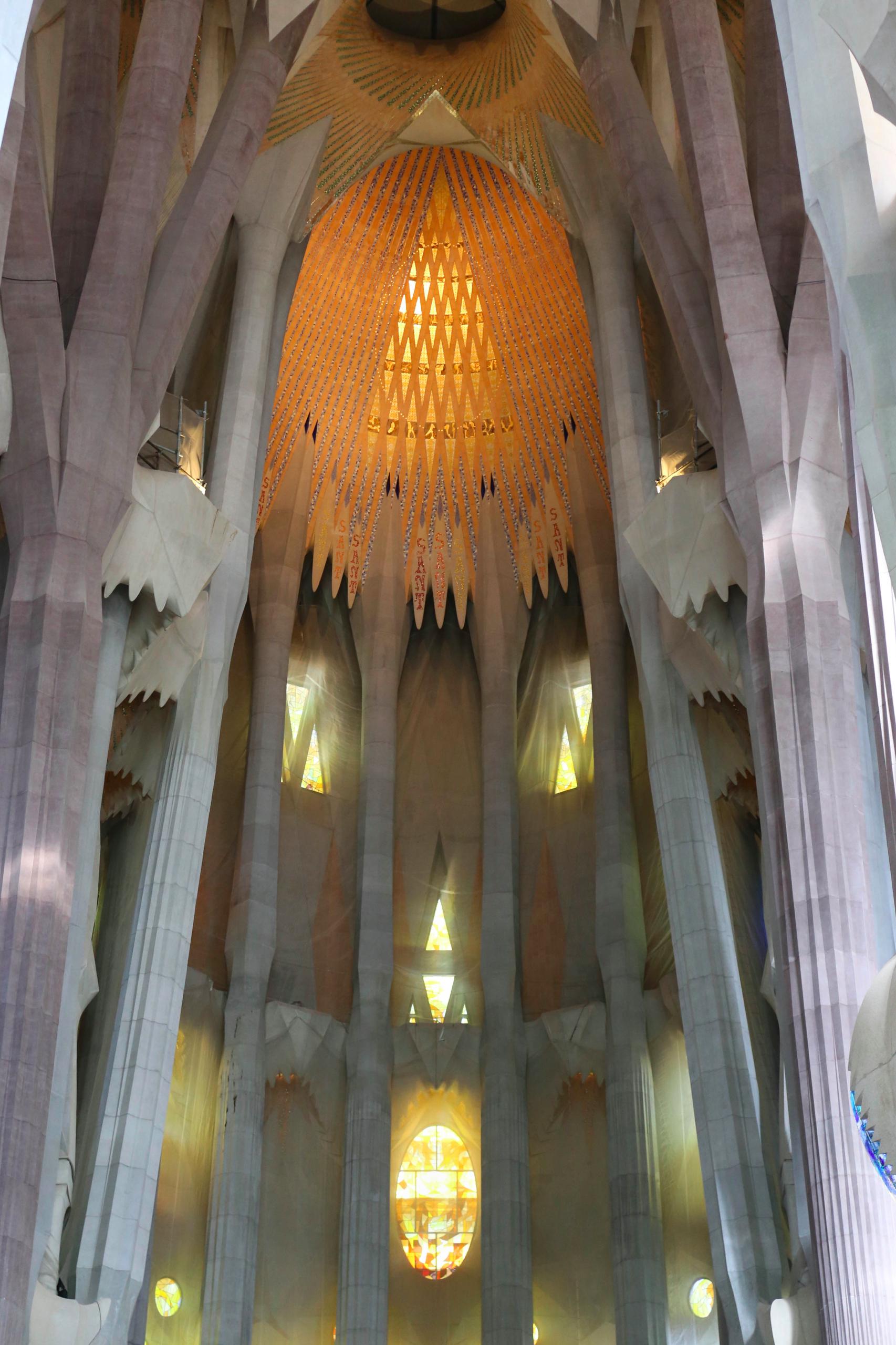
The gigantic volume of the interior of Sagrada Familia creates a wonderful perspective for visitors to reflect on the immensity of faith.
In June 1926, Gaudi was 73 years old. One day early that month he was heading to his daily confession. For a man with much on his mind he was likely lost in his thoughts and not paying much attention to his surroundings. Tragically, he was struck by a streetcar, and because of his appearance and not having any identification with him, he was mistaken for a beggar and taxi drivers refused to take him to a hospital. A doctor in the area gave him a cursory once-over and concluded nothing more could be done. Finally a policeman took him to a hospital, but Gaudi was only given minimal care, based on the assumption he was a pauper. By the time — a day later — a priest from Sagrada Familia recognized who the patient was, it would be too late. Antoni Gaud died two days later on June 10.
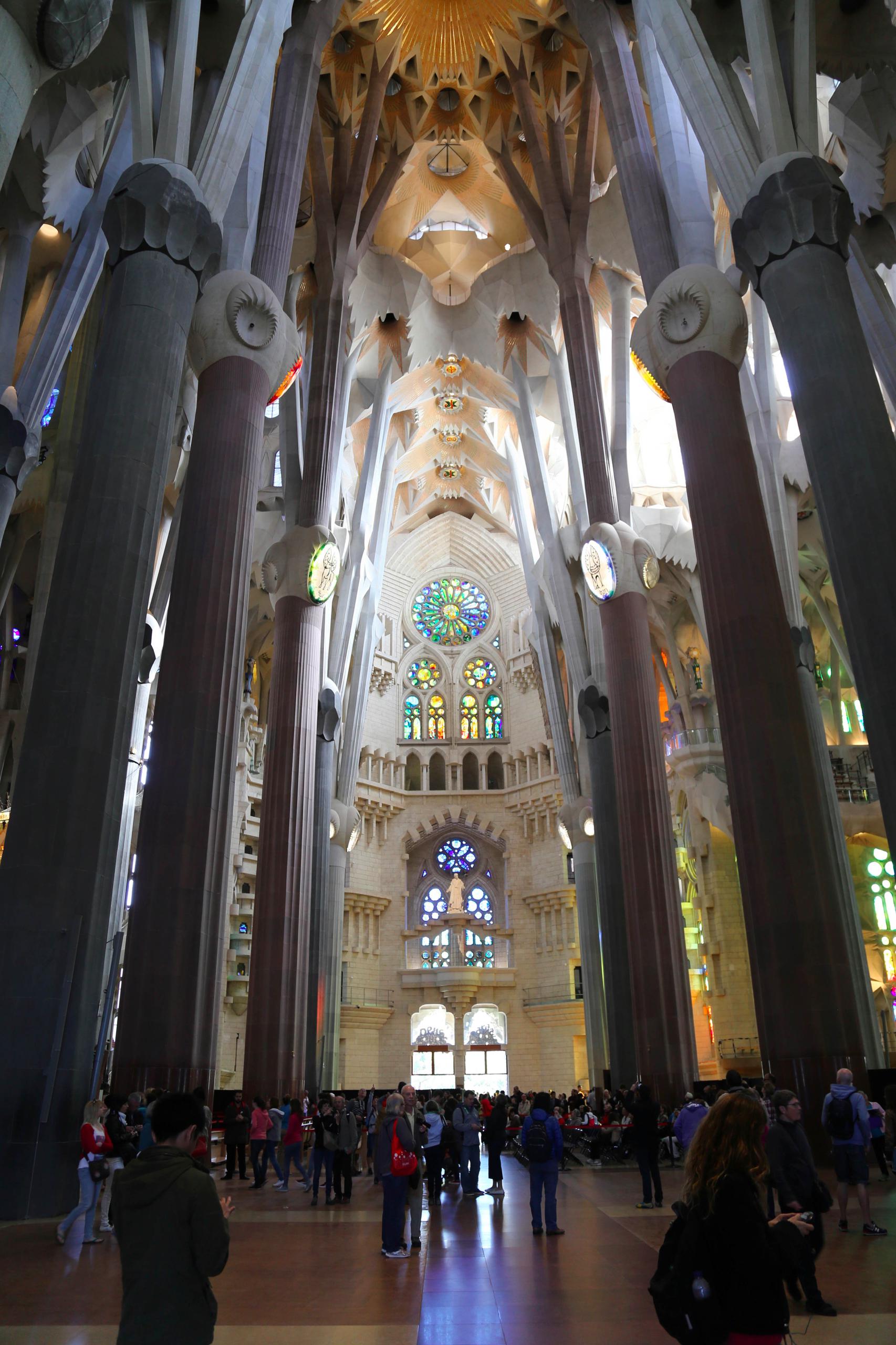
When Gaudi died in 1926, this view of Sagrada Familia would not be completed for many decades.
Gaudi’s death sparked an outpouring of mourning from Barcelonans and the funeral procession snaked throughout the city and finally ended up at Sagrada Familia. He was laid to rest in the crypt where he first began work at Sagrada Familia 44 years earlier.

Everywhere you look inside the basilica one sees spiritual devotion and adoration.
Work on Basílica i Temple Expiatori de la Sagrada Família continues, and plans call for its completion around 2026. The site has already been designated a UNESCO World Heritage Site (one of seven projects designed by Gaudi, all in Barcelona). Currently the 48,000-plus square foot church attracts more than 2.5 million visitors each year from all over the world and it is the top attraction in Barcelona.

A visit to Sagrada Familia offers stunning views at nearly every turn and is testament to the great care and attention Gaudi designed, even something as simple as an iron railing.
While there is no doubt about the grandeur and awe inspiring beauty of Sagrada Familia, Antoni Gaudi would almost certainly remind you that first and foremost his creation is a house of worship intended for the glory of God.

Antoni Gaudi died more than 90 years ago, but the designs and plans he created for Sagrada Familia, like complex multifurcation of the interior columns, are being followed by the current team of designers and builders.
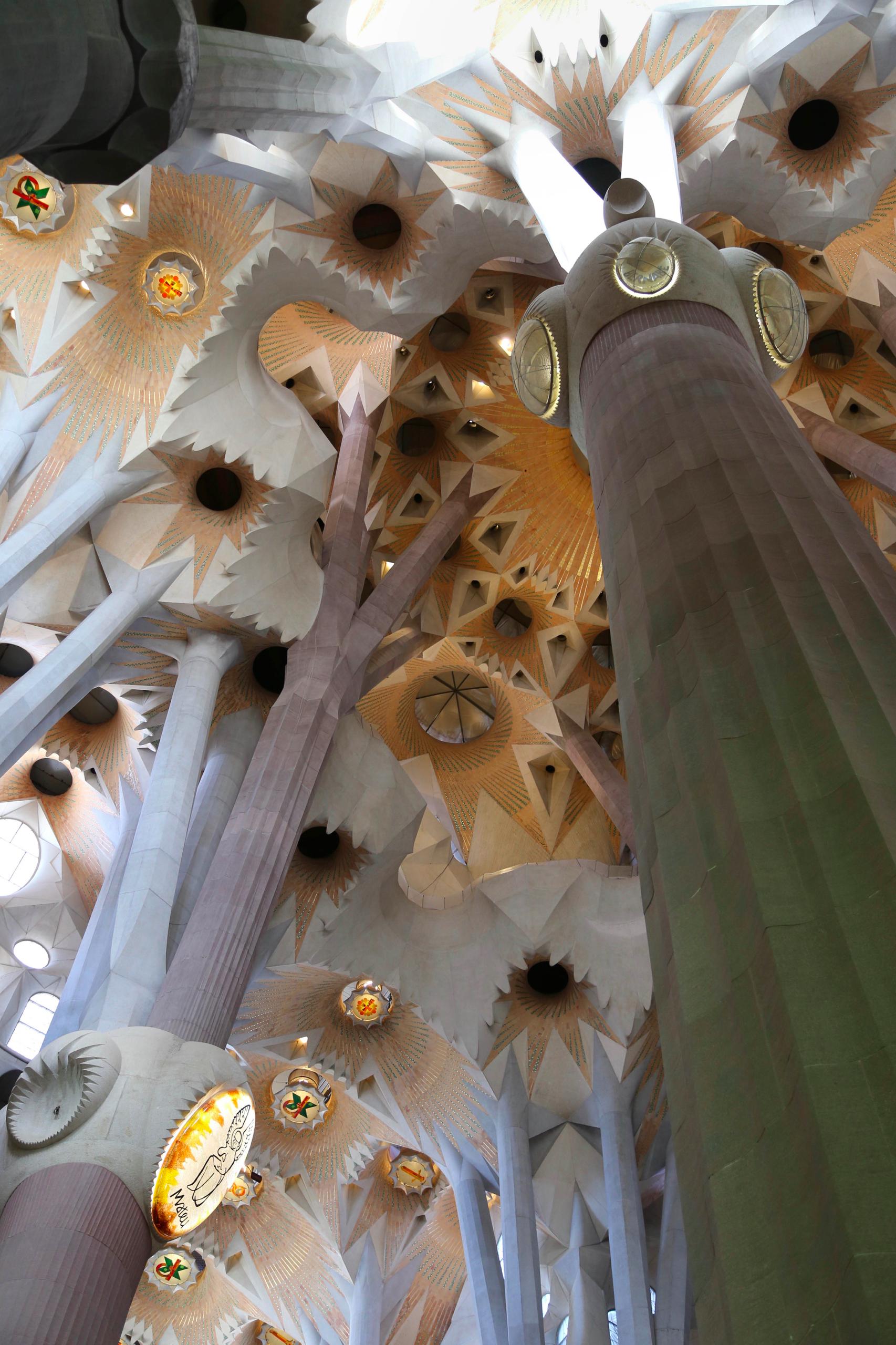
Sagrada Familia combines and reflects brilliant engineering, a reverence of nature and a sense of design that results in one of the most beautiful churches in the world.
For more information about Antoni Gaudi and Sagrada Familia, click over to these websites:
loud1design/geometry-study-of-the-columns-of-the-sagrada-familia/
barcelona.de/barcelona-sagrada-familia
theartstory/artist-gaudi-antoni
theculturetrip/11-awesome-facts-about-antoni-gaudi
